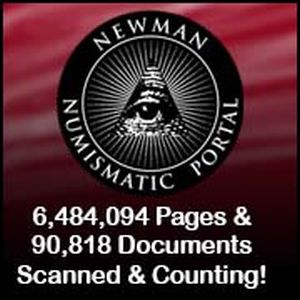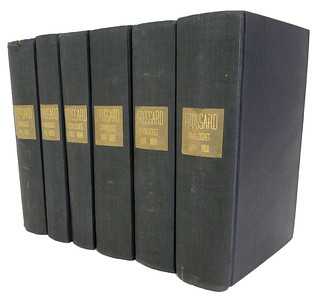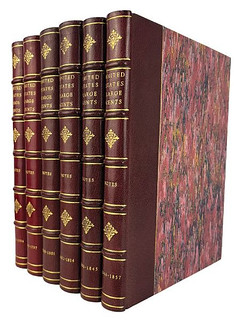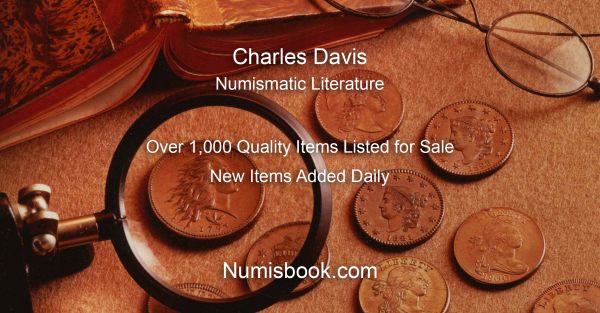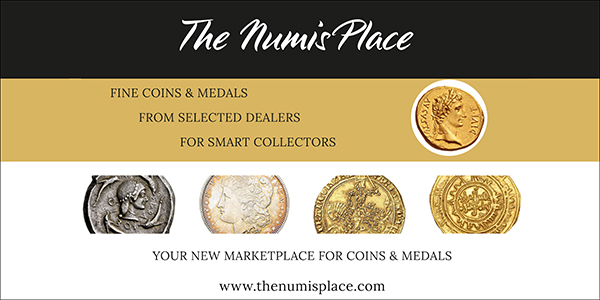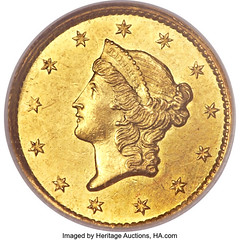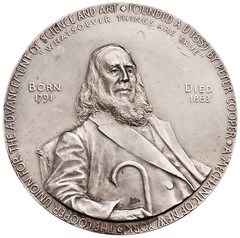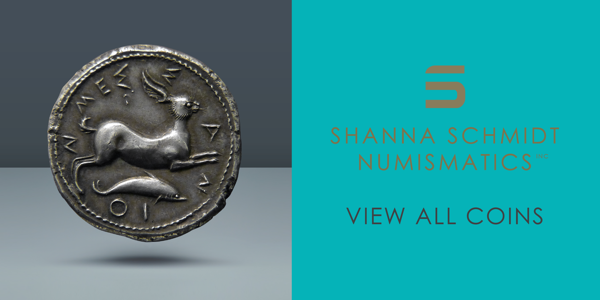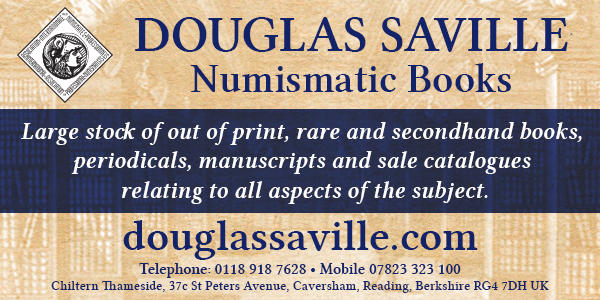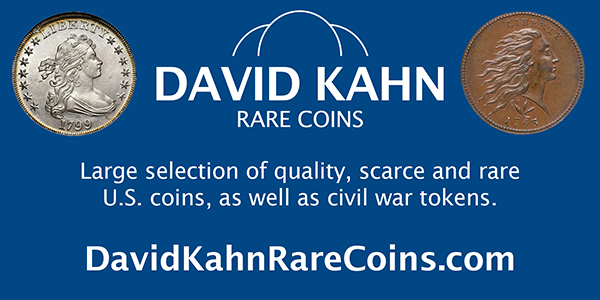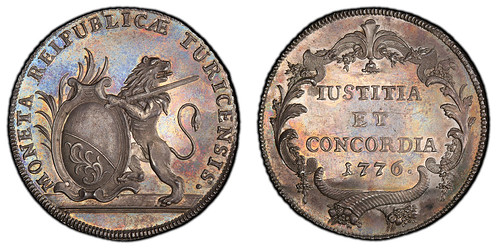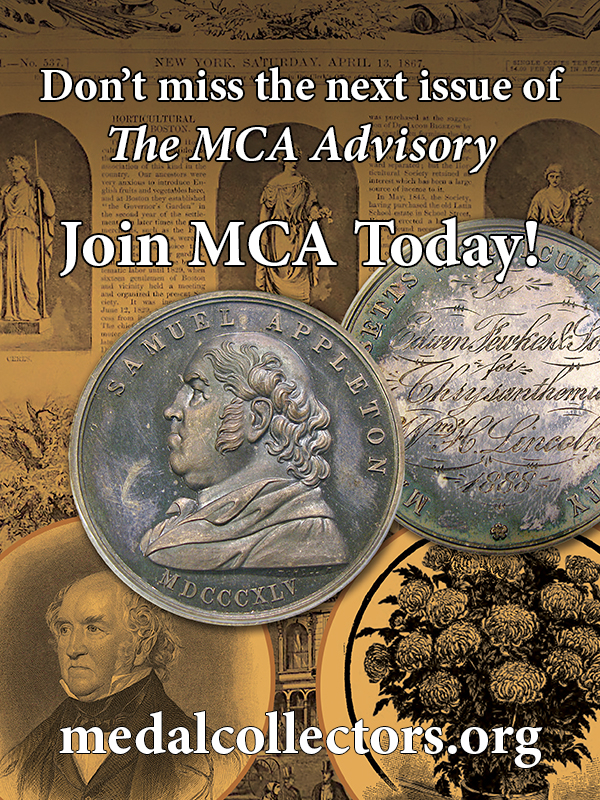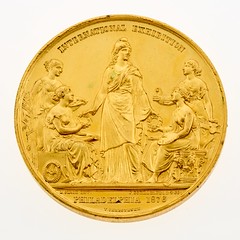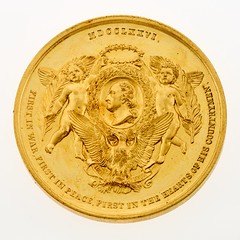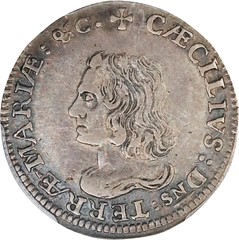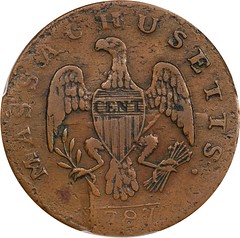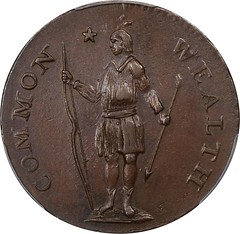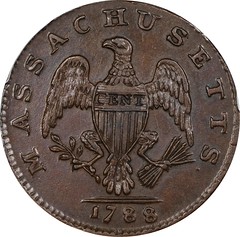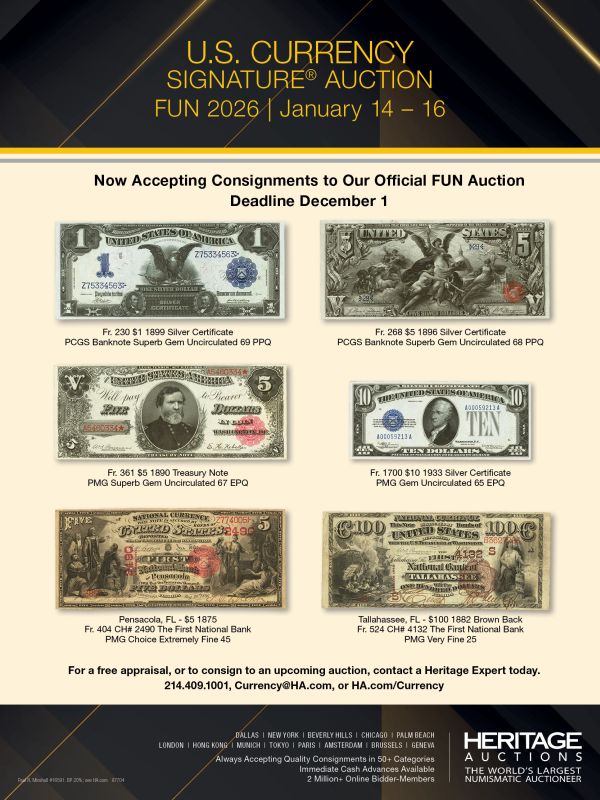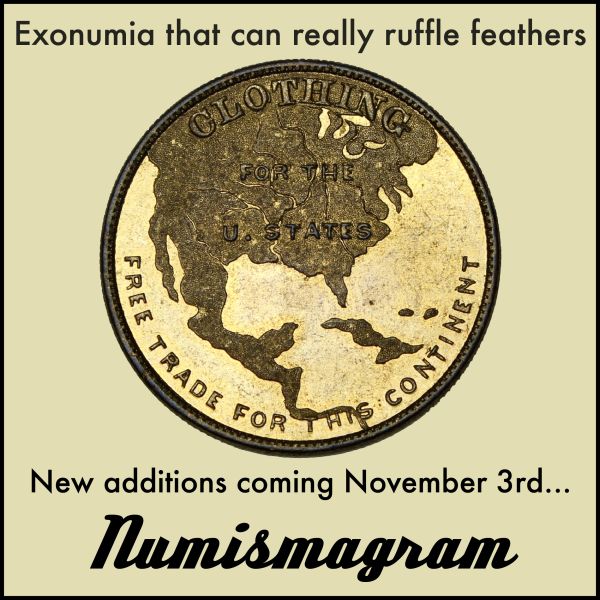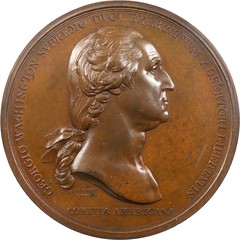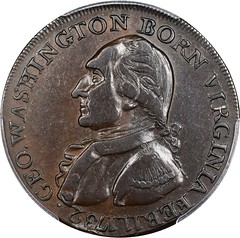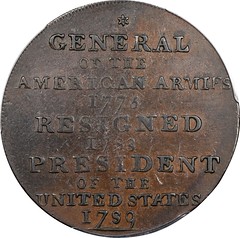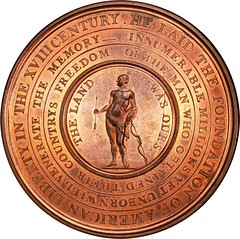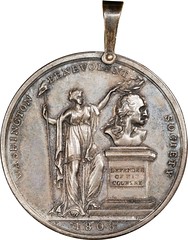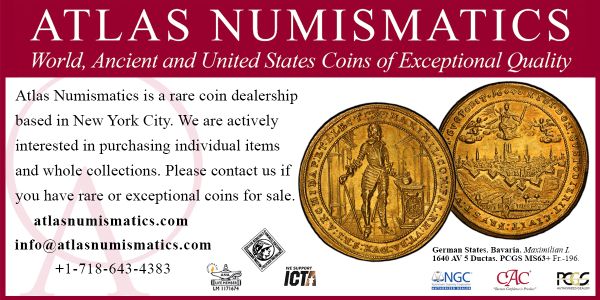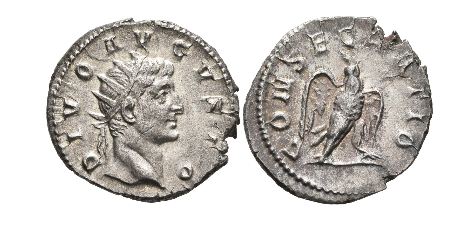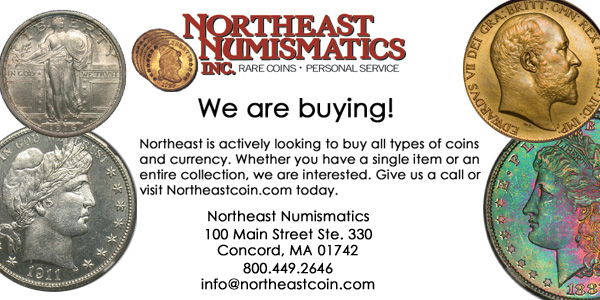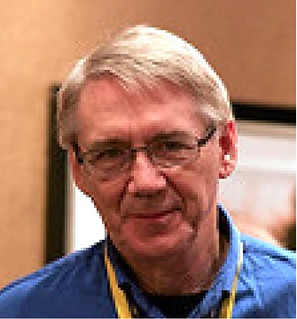
Visit our NBS Sponsors
About UsThe Numismatic Bibliomania Society is a non-profit association devoted to the study and enjoyment of numismatic literature. For more information please see our web site at coinbooks.org SubscriptionsThose wishing to become new E-Sylum subscribers can go to the following web page
Subscribe
MembershipThere is a membership application available on the web site Membership Application To join, print the application and return it with your check to the address printed on the application. Print/Digital membership is $40 to addresses in the U.S., and $60 elsewhere. A digital-only membership is available for $25. For those without web access, write to: Jeff Dickerson, Treasurer AsylumFor Asylum mailing address changes and other membership questions, contact Jeff at this email address: treasurer@coinbooks.org SubmissionsTo submit items for publication in The E-Sylum, write to the Editor at this address: whomren@gmail.com BUY THE BOOK BEFORE THE COINSale CalendarWatch here for updates! |
- WAYNE'S WORDS: THE E-SYLUM NOVEMBER 2, 2025
- KOLBE & FANNING NOVEMBER 2025 SALE ANNOUNCED
- L.E. BRUUN'S PERSONAL LIBRARY SALE
- NEW BOOK: MEROVINGIAN COINS
- NEW BOOK: NEPTUNE'S FORTUNE
- BOOK REVIEW: THE NUMISMATIST'S GUIDE
- B. MICHAEL THORNE (1942-2025)
- NEW BOOK: THE CHARLOTTE MINT 1837–1861
- NUMISMATIC TRICK-OR-TREAT FOR HALLOWEEN
- VIDEO: BRANCH MINT AT DAHLONEGA, GEORGIA
- NOTES FROM E-SYLUM READERS: NOVEMBER 2, 2025
- VOCABULARY TERM: SAND CAST, SAND CASTING
- ALPHONSE ANTON KOLB (1893-1983)
- MINT'S DIRECTOR NOMINEE PAUL HOLLIS TESTIFIES
- MSNS FALL 2025 CONVENTION SPEAKERS
- ATLAS NUMISMATICS SELECTIONS: NOVEMBER 2, 2025
- DOYLE NOVEMBER 4, 2025 WASHINGTONIA SALE
- STACK'S BOWERS: RICHARD AUGUST COLLECTION
- KUENKER AUCTION SALE 432
- STACK'S BOWERS: JOHN PACK WASHINGTONIANA
- HERITAGE: NOV. 13-14 U.S. COINS SIGNATURE
- THE RESTORATION COINAGE OF TRAJAN DECIUS
- 1715 FLEET: A 1703 LIMA MINT EIGHT REALES
- ON ARCHAEOLOGISTS AND TREASURE HUNTERS
- BARCLAY'S BANK CARIBBEAN BANKNOTES
- AMERICAN MINT SETTLES PENNSYLVANIA LAWSUIT
- LOOSE CHANGE: NOVEMBER 2, 2025
- ARGOSY BOOK STORE'S 100TH YEAR
- ABOUT THIS ISSUE: NOVEMBER 2, 2025
Content presented in The E-Sylum is not necessarily researched or independently fact-checked, and views expressed do not necessarily represent those of the Numismatic Bibliomania Society.
WAYNE'S WORDS: THE E-SYLUM NOVEMBER 2, 2025
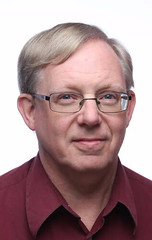 New subscribers this week include:
Stephanie Hudson.
Welcome aboard! We now have 6,805 subscribers.
New subscribers this week include:
Stephanie Hudson.
Welcome aboard! We now have 6,805 subscribers.
Thank you for reading The E-Sylum. If you enjoy it, please send me the email addresses of friends you think may enjoy it as well and I'll send them a subscription. Contact me at whomren@gmail.com anytime regarding your subscription, or questions, comments or suggestions about our content.
This week we open with three new books, two book reviews, an obituary, updates from the Newman Numismatic Portal, and more.
Other topics this week include Merovingian coins, the Charlotte and Dahlonega mints, sand casting, Alphonse Kolb, Paul Hollis, Mike Thorne, MSNS convention speakers, fixed price and auction previews, the 1715 Fleet, the American Mint and the Argosy Book Store.
To learn more about Russian numismatics, L.E. Bruun's library, Neptune's Fortune, The Numismatist's Guide, Postmaster Alonzo H. Sawyer, the $16 Moffat ingot, U.S. Paper Money errors, the Excelsior Copper, the Presidency Resigned medal, archaeologists and treasure hunters, gates, sprues and vents, Brown Friday and A Guide to Chocolate Coins, read on. Have a great week, everyone!
Wayne Homren
Editor, The E-Sylum
KOLBE & FANNING NOVEMBER 2025 SALE ANNOUNCED
Kolbe & Fanning have announced their next numismatic literature sale, featuring books on Russian, ancient, world and U.S. numismatics. -Editor
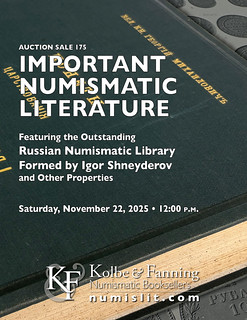 Kolbe & Fanning Numismatic Booksellers are pleased to announce that we will be holding our 175th auction sale on Saturday, November 22, 2025. Headlining the sale is the outstanding library on Russian numismatics formed by Igor Shneyderov, which includes most of the classic works on the subject. The sale also features a variety of rare and out-of-print works on ancient, world and U.S. numismatics, with notable material on Islamic coins from the library of the well-known former ANS Curator Michael Bates. With over 500 lots, there is something for everybody.
Kolbe & Fanning Numismatic Booksellers are pleased to announce that we will be holding our 175th auction sale on Saturday, November 22, 2025. Headlining the sale is the outstanding library on Russian numismatics formed by Igor Shneyderov, which includes most of the classic works on the subject. The sale also features a variety of rare and out-of-print works on ancient, world and U.S. numismatics, with notable material on Islamic coins from the library of the well-known former ANS Curator Michael Bates. With over 500 lots, there is something for everybody.
Some highlights of this first sale include:
Lot 227: an extraordinary set of the Grand Duke Georgii Mikhailovich's legendary corpus on Russian numismatics, one of the most important numismatic publications ever produced
Lot 204: a complete original set of Baron Chaudoir's classic work on Russian coins, being the superior Russian edition of 1837–1841
Lot 370: an 1881 volume of Portraits and Vignettes Engraved by the Bureau of Engraving and Printing, Treasury Department, never issued commercially
Lot 314: a set of the original superbly embossed plates prepared for General T.F. de Schubert's 1857 Monnayes russes des dernièrs trois siècles
Lot 352: George Kolbe's complete set, with all supplements, of the ANS Library catalogue, substantially augmented with hundreds of inserts
Lot 397: John J. Ford, Jr.'s immaculate copy of the rare plated version of Henry Chapman's 1911 catalogue of the Stanislaus Siedlecki collection of US, world and ancient coins
Lot 440: a plated copy of Tom Elder's 1917 catalogue of the George C. Carlton collection, featuring five superb photographic plates depicting mostly American coins and medals
Lot 436: a finely bound set of Penny-Wise, the publication of Early American Coppers, in tan half morocco, from the libraries of Roger Siboni, Syd Martin, and John Hoskins
Lot 443: the Stack Family set of the catalogues of Ed Frossard, including seventy-six catalogues bound in six volumes, four of them featuring original heliotype plates
Lot 474: a complete set of William C. Noyes's six-volume series on United States large cents, each finely bound in maroon quarter morocco.
Register early to bid online
Bids may be placed via post, email, phone, as well as online. Kolbe & Fanning use Auction Mobility as our third-party online bidding platform. Auction Mobility is an app-based platform allowing users the ability to participate in the sale through phones, tablets and computers. To register for the sale, bidders must go to
bid.numislit.com and sign up. Once you have set up an account, you may browse lots, place advance bids, or participate in the live sale online. Those wishing to participate on their devices can download the Kolbe & Fanning app through the Apple or Google Play Store. The sale will also be listed on Biddr and NumisBids.
The printed catalogue is being mailed to all active customers on our mailing list. As international mail speeds have been inconsistent, we encourage our foreign clients to consult the electronic catalogue in case their printed catalogue does not arrive promptly. A PDF of the printed catalogue has been posted to our main website at numislit.com for those who prefer that format. Bids placed via post, email, or phone must be received by November 21, the day before the sale, in order for them to be processed. Advance absentee bids may also be placed at any time online at bid.numislit.com. Internet bidding will be available during the sale itself through the same platform.
To bid in the sale, see:
https://bid.numislit.com/auctions/1-BH0HFN/important-numismatic-books-sale-175
To read the .pdf catalog, see:
https://numislit.cdn.bibliopolis.com/images/upload/kolbefanningsale175.pdf
L.E. BRUUN'S PERSONAL LIBRARY SALE
This short Facebook reel gives a first look at L.E. Bruun's personal reference library coming to auction soon. There are over 2,000 volumes. This is our first attempt at embedding a video from Facebook, so let us know if you're having any issues. -Editor
To watch the reel on Facebook, see:
https://www.facebook.com/share/r/1BWiivnF3H/
NEW BOOK: MEROVINGIAN COINS
France's Society for Numismatic and Archaeological Studies has published the 12th volume of its Research and Works of the Society, focusing on Merovingian coins. Co-author Philippe Schiesser submitted this overview in English. Thank you. The book is entirely in French. -Editor
 DU TRÉSOR ROYAL AU SALAIRE DE LA MINE MONNAIES, MONÉTAIRES ET POUVOIRS MÉROVINGIENS Recherches et Travaux de la Société d'Études Numismatiques et Archéologiques n° 12, Société d'Études Numismatiques et Archéologiques (SÉNA), Paris, 2025.
DU TRÉSOR ROYAL AU SALAIRE DE LA MINE MONNAIES, MONÉTAIRES ET POUVOIRS MÉROVINGIENS Recherches et Travaux de la Société d'Études Numismatiques et Archéologiques n° 12, Société d'Études Numismatiques et Archéologiques (SÉNA), Paris, 2025.
FROM ROYAL TREASURY TO MINE WAGES: MEROVINGIAN COINS, MONETARY, AND POWERS, Research and Works of the Society for Numismatic and Archaeological Studies n° 12. Book entirely in French.
Inès Villela-Petit, Karim Meziane et Philippe Schiesser (dir.),
SENA Members: €35 France, €45 Outside France
Public price France including shipping €40, Public price Outside France including shipping €50
SENA alternates between publishing proceedings of regional conferences and thematic volumes. The first category includes volumes on numismatics in Poitou-Charentes (RTSÉNA 2), numismatics in Normandy (RTSÉNA 4), Breton numismatics (RTSÉNA 6), Monegasque and Provençal numismatics (RTSÉNA 8), coinage in Metz and Lorraine (RTSÉNA 9), coins and coinage in Avignon, between Provence and the Papacy (RTSÉNA 10), and coinage in Troyes and Champagne (RTSÉNA 11); to be followed soon by numismatics in Béarn (Pau conference, 2023) and numismatics in Anjou and along the Loire (Angers conference, 2025). Several include articles that align with the theme of this volume: Coins, Moneyers, and Merovingian Power.
Previous thematic issues, in addition to counterfeit coins (to which RTSÉNA 6 was also devoted), have focused on the army and coinage (RT SÉNA 1 and 3), Celtic numismatics (RTSÉNA 5, a collection of essays in honor of Louis-Pol Delestrée), and Merovingian numismatics through the silver coinage of Touraine (RTSÉNA 7). RTSÉNA 7 thus paved the way for us by clarifying the chronology of the appearance of the denier (c. 670) and demonstrating the importance of silver coinage through the Touraine corpus.
The submissions of articles on Merovingian coins, both in the Cahiers Numismatiques and at the SÉNA regional conferences, reflect the rapid renewal of research and the growing interest of numismatists. The response to the call for papers for this volume confirms this: unpublished works and in-depth articles have already filled not one, but two issues of the RTSÉNA journal on Merovingian coinage. This coinage is indeed abundant, both in terms of the variety of types and the number of surviving examples: Guillaume Blanchet inventories 1,124 argentei in his thesis; Arent Pol lists 12,000 gold coins in his database (solidi and tremisses), and Philippe Schiesser lists almost as many denarii, as well as about a hundred silver obols.
Research in Merovingian numismatics is also benefiting from the general revival of interest in the period, through archaeological excavations, the considerable amount of newly unearthed material, and exhibitions, notably in 2016-2017: "The Merovingian Era" at the Musée de Cluny in Paris and "Austrasia." The forgotten Merovingian kingdom at Saint-Dizier and the National Archaeological Museum in Saint-Germain-en-Laye, and recent studies on the structures of Merovingian power, are challenging received ideas and dispelling the negative images left to us by 19th-century authors.
This conceptual constraint, which distorted our perspective, is that of Maurice Prou's introduction to his Catalogue of Merovingian Coins in the National Library (1892), although it remains a standard reference. The idea of ??a disintegrated state and obscure moneyers taking the initiative in minting coins is, however, obsolete since the importance of the chancery and the palace of the Frankish kings, direct heirs to imperial practices, has been highlighted. Nevertheless, the number of mints is vastly greater than the three mints in Roman Gaul and Germania operating in Arles, Lyon, and Trier at the beginning of the 5th century. Around 700 minting sites, both permanent and temporary, are attested in the 6th and 7th centuries through place names associated with coins, primarily for gold, but others remain unidentified.
In any case, they seem to reveal the control exercised by the central administration of the Frankish kings from their capitals (the sedes regni) or their palaces (the palatium) through a dense territorial network, as evidenced by both the distribution of place names and that of coin finds and hoards. The place names identified in the Prou ??region would, moreover, require a general revision, as the linguist Jean-Pierre Chambon demonstrated twenty years ago through the study of a sample of names of mints in Auvergne, half of which turned out to be incorrectly identified. Nevertheless, the "money-makers' coins," so characteristic of Merovingian coinage, which are unique in that they lack the name of a sovereign, reflect both a system of government by delegation and a centralized monetary policy, implemented around 581-582, at the height of Frankish power.
From its inception, the SÉNA has been committed to disseminating information impartially and not limiting publications to institutional authors, a commitment all the more justified in a field as diverse as Merovingian numismatics. Thus, the contributions of a new generation of researchers join the work of established authors, both French and international. The articles express the opinions of their authors and may, in some cases, contradict each other, but this is a deliberate choice, so as not to conceal the difficulties faced by researchers and to showcase the scholarly reflection in progress; we have allowed these divergences to be expressed. The interpretation of the monograms is one example, as documentary evidence is so lacking that it is difficult to transform the appealing hypothesis into a certainty and to decide between possible readings.
Editor's notes [Ed.] summarize, where applicable, the ongoing debates and the alternatives. The contributions gathered in this first volume cover all periods of Merovingian coinage: from imperial imitations (before 581), to the gold coinage known as that of the moneyers (c. 582–c. 670), and silver coinage (c. 670–c. 750); from all parts of the kingdom (regiones rather than Teilreiche), from Austrasia to Aquitaine, including Provence, with forays into more distant territories: Rome and the Byzantine Empire; and from all aspects of Merovingian numismatics, including classification and toponymy, typology and corpora, iconography and economics, the history of institutions and metrology, with several case studies.
Using a silver coin of Childebert I as a starting point, Christophe Adam offers a new interpretation of royal monograms, comparing them to toponymic monograms. Thibault Cardon proposes a stylistic and geographical classification framework for the tremisses of the Merovingian kingdoms, using Austrasia as an example. He emphasizes the territorial boundaries established by the regio.
Based on Arent Pol's study of the coinage of Rouergue (the pagus rutenicus), Inès Villela-Petit examines monetary place names for what they reveal about power structures through their distribution in the peripheries. Villela-Petit also focuses on the career of a moneyer-goldsmith contemporary with Saint Eligius: Haribald, who may have worked successively in Rodez, Clermont d'Auvergne, and Marseille. Fernando López-Sánchez reveals papal control over the "quasi-imperial" coinage of Marseille during the reign of Childeric II, and the monetary commemoration of the reception of the Byzantine Emperor Constans II at St. Peter's Basilica in Rome.
Philippe Cossettini revisits Provençal coinage from the last quarter of the 7th century, focusing on a political interpretation of "weak signals" based on rare archival and chronicle references.
Samuel Gouet and Philippe Schiesser study a hoard of Merovingian deniers found at Queudes (Marne), on the border of the three kingdoms of Neustria, Austrasia, and Burgundy.
Daniel Patarin examines Candes-Saint-Martin (Indre-et-Loire), the site of Martin of Tours' death at the confluence of the Vienne and Loire rivers, from where the saint's body was transported to Tours by barge. The author gathers evidence of a moneta (a type of coin).
Similarly, Christophe Adam proposes attributing the deniers of Leodegiselus with the bearded face, and the triens that precede them, to a "Mound of Theodebert" still visible in the urban landscape of Thiverzay (Vendée).
Finally, Bernard Seguin presents the long-awaited catalogue of Merovingian silver coinage from Melle (Deux-Sèvres), focusing on three types: deniers and obols with a large cross-shaped A, a large uncial M also with a cross, and the monogrammed letters ME. Philippe Schiesser also presents the equally anticipated catalogue of uniface obols or bracteates, subdivisions of deniers, which extend into the Carolingian period.
This diversity of approaches and perspectives, of research avenues, both traditional and more original, is what makes contemporary Merovingian numismatic studies so rich.
To order, see:
https://www.sena.fr/rt-s%C3%A9na
For more information, contact:
numismate@yahoo.fr
NEW BOOK: NEPTUNE'S FORTUNE
A new book to be released in January chronicles the story of the legendary Spanish galleon the San José. See also two other articles elsewhere in this issue related to this book and the 1715 Fleet. -Editor
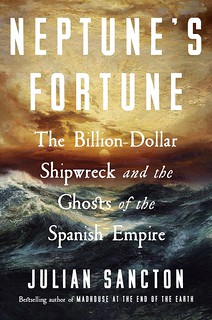 Neptune's Fortune: The Billion-Dollar Shipwreck and the Ghosts of the Spanish Empire
Neptune's Fortune: The Billion-Dollar Shipwreck and the Ghosts of the Spanish Empire
by Julian Sancton (Author)
Roger Dooley wasn't looking for the San José. But an accidental discovery in the dusty stacks of a Spanish archive led him to the story of a lifetime, the tale of a great eighteenth-century treasure ship loaded with riches from the New World and destined for Spain. But that ship, the galleon San José, met a darker fate. It was drawn into a pitched battle with British ships of war off the coast of Cartagena, and when the smoke cleared, the San José and its bounty had disappeared into the ocean, its coordinates lost to time.
Though a diver at heart, Dooley was an unlikely candidate to find the San José. He had little in the way of serious credentials, yet his tenacity and single-minded devotion to finding and excavating the ship powered him across four decades, even as he became a man in exile from the country of his birth. As Dooley jousted with famous treasure hunters and well-funded competitors, he slowly homed in on a patch of sea that might contain a three-hundred-year-old shipwreck—or nothing at all.
Neptune's Fortune is a thrilling adventure, taking readers from great naval battles on the high seas to the sun-soaked shores that nurtured history's most notorious treasure hunters, to the archives that held the secret keys to lost fortune on the ocean floor.
Publisher ? : ? Crown
Publication date ? : ? January 27, 2026
Language ? : ? English
Print length ? : ? 384 pages
ISBN-10 ? : ? 0593594177
ISBN-13 ? : ? 978-0593594179
Item Weight ? : ? 1.35 pounds
Dimensions ? : ? 6.13 x 1 x 9.13 inches
For more information, or to pre-order, see:
Neptune's Fortune: The Billion-Dollar Shipwreck and the Ghosts of the Spanish Empire
(https://www.amazon.com/Neptunes-Fortune-Billion-Dollar-Shipwreck-Spanish/dp/0593594177)
THE BOOK BAZARRE
BOOK REVIEW: THE NUMISMATIST'S GUIDE
Dr. Lawrence J. Lee has a longtime interest in numismatic scholarship and disdain for the lack of academic numismatic programs in the U.S. At my request, he submitted this review of Patrick O'Connor's new book, The Numismatist's Guide. Thank you! It takes a lot of time and thought to review a book, particularly one as large and detailed as this. -Editor
 O'Connor, Patrick. The Numismatist's Guide: Standard Reference for the Study of Coins and Paper Money. San Antonio, TX: Aurora Rarities, LLC, 2025. English, 420 pages, full color.
O'Connor, Patrick. The Numismatist's Guide: Standard Reference for the Study of Coins and Paper Money. San Antonio, TX: Aurora Rarities, LLC, 2025. English, 420 pages, full color.
Patrick O'Connor has written what can accurately be described as a textbook of numismatic knowledge. His book, The Numismatist's Guide: Standard Reference for the Study of Coins and Paper Money (hereafter, the Guide) not only lives up to its name, but provides a process so that the book can continue to grow and improve as new information is gathered and inserted.
And to be honest, the numismatic community has needed a systematic approach to the study of coins for decades. What has long been considered the numismatic go-to textbook has been Philip Grierson's fifty-year old classic by that very name, Numismatics. Grierson was an expert on medieval and Byzantine coinage, but he actually used coins as an adjunct to teach history, his primary interest. Thus, the first half of his book is on the history of coinage, starting with Greek, Romans and other ancient cultures, moving then onto the Eastern cultures of coinage and finally modern European traditions. It is not until rather late in the book that he begins talking about coin symbolism, minting techniques, coin hoards and, finally on page 140, dealing with the actual techniques and metrology the numismatist will employ. Grierson also wrote primarily on "ancient" coinage, he wrote before the era of grading companies and colored stickers, and the Newman Portal, to say nothing of XRF machines, were unimagined complications to the science of numismatics.
Most other "Introductions to Coins" take the same approach as Grierson: the history of coins starting with the Greeks first, then later, if at all, information about how to treat them as objects. O'Connor correctly gets the horse in front of the cart and within the first chapter is discussing assaying and metallurgy.
Patrick's infatuation with coins followed the same genetic trajectory as many coin collectors. As a youngster he found a jar of coins his father had put aside, was intrigued by some of the older ones and the next thing you know, young Pat is placing ads to buy and sell coins in the local newspaper. As a teenager.
Again, like many hard-core numismatists, coins became secondary while Patrick obtained a B.S. in Engineering from Trinity University and established a career and a family. But the genetic pull of coins never abated and when he was a little older, he once again became a part-time coin dealer, establishing Aurora Rarities, LLC in south Texas. He also found time to write his first book: The Coins of Queen Isabel II of Spain (2017). It was well received in both Spain and the United States as well as in the Philippines, where Queen Isabel is a national favorite.
O'Connor started systematizing his numismatic knowledge with the hope of one day writing the very book now under review. He has done an admirable job of gathering together the many strands that make up the science of numismatics into a single, organized structure. And organized it is. The entire book is laid out as one giant outline, with Arabic numerals dividing the chapters, sections and subsections. Every subject has an entry and new subjects and commentary can be added as the need arises. His outline system is so precise that, for instance, "numismatic notation" has its own sub section (2.5.4), as do "desiccants" (2.6.2.1). Know of a slick way to remove glue from a coin using low heat? That would go in Chapter 2: Numismatic Fundamentals Section 2 Subsection 6. Paragraph 3: Common Procedures for Conserving Coins. Have an insight on self-publishing? Chapter 4, section 7. Paragraph 4 would be the place to insert that information. O'Connor invites the numismatic community to add their own insights to the book so that the knowledge base continually grows. The outline format that he has organized the book into easily facilitates the addition of new nuggets of information.
O'Connor divides the Guide into four sections: The Nature of Money, Numismatic Fundamentals, The Numismatic Community and The Role of the Numismatist. From the chapter titles alone, it is obvious O'Connor is taking an all-inclusive approach, covering everything from minting technology to photographic lighting for coins to the role of the independent author. Along the way he also manages to hit on dealer ethics, grading, and the relationship between price guides and value, among a myriad of other related topics.
The Nature of Money
This section gives an overview on the development of trade, the role of primitive money and a brief history of coinage. He then jumps right into metrology and minting methods, including a brief survey of paper money that discusses paper making and printing techniques.
Numismatic Fundamentals
This is the heart of any text on numismatics, as it should be. Besides identification, authentication, valuation, preservation and photographing of coins, O'Connor also delves deep into conservation, an area of special interest for him and one where he continues to experiment and test new techniques. His love for the subject is shown by the sixty pages he devotes to conservation techniques and insights.
The Numismatic Community
This was a welcome addition to any book on numismatics: a discussion of the players involved. O'Connor covers dealers, auction houses, third party grading services, mints, numismatic organizations and social media—all important background and supporting entities to the collector. He also discusses international, federal and state regulations as they apply to the individual collector.
The Role of the Numismatist
Yet another great section is on the role of the numismatist. What is the difference between a coin collector and a numismatist? What is his collecting philosophy? What are his ethics? How do you become a dealer? How do you become a serious researcher? What jobs or independent work is there for the studious numismatist?
O'Connor closes his book with a nice collection of appendixes linked to every topic he has covered: from numismatic literature to international regulations. Each appendix has a bibliographic reference for more information about that subject.
When I have reviewed other articles and books in the past about numismatic education, I notice several areas of minutiae that are usually overlooked. I am pleased to see that O'Connor addressed several of my concerns.
First, he is among the few I've noted who realized the importance of a firm understanding of dating and calendar systems to numismatics. Many years ago, I asked Ken Bressett what book or books he would recommend as a numismatic textbook. Besides Grierson's Numismatics, mentioned previously, Ken also suggested Tempus in Nummis by James Sweeny and Robert Turfboer (1992). This delightful but often overlooked 2-volume set discusses numerals and numbers, calendar systems and calendar medals, era dating, temporal symbols and the art of the chronogram, or covert dates on coins. This important sub-sub-subject is not always recognized—O'Connor spends several pages on calendar systems (Section 2.1.1.1).
He also understands that heraldry is a visual alphabet for the illiterate, so that any stable boy would recognize whose coach belonged to who based on their coat-of-arms. Extended to coinage, particularly from the time of the Renaissance, a firm understanding of heraldry can allow instant identification of otherwise problematic coins. O'Connor gives a good introduction to the subject.
The problem from a critical reviewer's perspective is that whatever negative thing I could think to say about this work (and there is virtually nothing), the very act of me pointing it out would necessitate me being the one who corrected it! Pretty clever, Pat.
That being said, there were a few things I noticed that in future editions will probably be more fully addressed. The first of these would be an index at the back of the book so old guys like me don't have to remember which page the stuff about heraldry was on: I could just look up in the index.
And when it comes to numismatic research (2.8.1), I would like to see a few points about adult education and about research methods emphasized that often are overlooked.
Regarding numismatic education, it is important to note that children and adults learn differently, or in educational parlance, the difference between pedagogy and andragogy. "Coins in the Classroom" and Boy Scout merit badges are worthy efforts but they should not be confused with numismatic research at the level necessary to be recognized scholastically. O'Connor's textbook is just that: a deep, encompassing work that is definitely at the post-graduate level.
Regarding research methods, the numismatic community is usually fairly scholastic in their approach when it comes to quantitative research. That is, we can weigh and measure and compare and contrast coin data with the best of the STEM folk. Because whether they realize it or not, (and the point of numismatic research is to get them to realize this), coin researchers generally follow the standard methodology format for quantitative research: Statement of the Problem (Were the coins of King X debased?); Review of the Literature (Here's what everyone who ever studied the problem said about it); Proposal (Here's what we are going to try differently); Data Collection (Weigh and measure); Data Analysis and Conclusion (Yup, he was short-changing his subjects). Rinse and repeat, as this is the essence of quantitative research. Different researchers should be able to look at the same coins, measure them and come to the same conclusions.
Not so with qualitative research methods, an area where the greatest amount of numismatic "research" masquerades as being "educational." Because qualitative research, while a valid method of investigating and arriving at "truth", is not replicable. That is, if three different people interview Q. David Bowers at three different times, they are not going to get duplicative results, because they will ask different questions, things would have changed in Bowers's life in the interim and their level of numismatic knowledge may be widely variant. Their research is still valid; it just is not as reproducible as is quantitative research.
As a consequence, qualitative researchers have developed a series of guidelines and rules that they follow for their work to be considered valid, just as with quantitative researchers. And this is the very area where, as numismatic educators, we fail to hit the mark, because our qualitative research rarely rises above the level of ‘Review of the Literature', reworded. I think, for instance, of the private gold minting company of Clark, Gruber & Co., where not a single new fact has been added to their storyline in 100 years of "research", but a simple peek behind the curtain would reveal such unknown tidbits as: the largest ginkgo tree in Kansas is in the front yard of the still standing Clark mansion in Leavenworth, a gift of the Japanese ambassador. Emanuel Gruber built a huge mansion, never lived in it, paid someone to take his place in the Civil War and yet is buried in Arlington Cemetery. And one more. The other Clark's daughter was a model for both the Gibson Girls and Coca-Cola trays. And you thought Clark & Gruber just made nice gold coins.
O'Connor's research clearly does not have the "reword the literature" problem. He says his book "provides a foundation of numismatic knowledge, including many aspects never before addressed in other books. It clarifies basic information and pulls back the curtain on advanced concepts known only to insiders. It promises to enlighten and serve as a handy reference for both expert and novice collectors." He hopes the Guide will make numismatics more approachable to people who might not otherwise study it and serve as a foundation the numismatic community can discuss and build upon. I heartily applaud O'Connor's efforts and congratulate him on helping the community take a giant step forward in numismatic education.
The first edition of the Guide has sold out and the second printing should be available by Thanksgiving on Apple eBook. O'Connor hopes the Guide can be published for a target price of $42, which is pretty cheap for a college-level course in numismatics. More and more accurate information can be found on Patrick's web-site: https://www.thenumismatistsguide.com/the-book.html
After it is all said and done, I can only give Patrick and his Numismatist Guide the highest compliment one author can offer another: I wish I would have written that book.
Patrick adds:
"The first edition hardbound at $196.00 has sold out. The ebook is now available from Apple Books for $39.99. The latest information on the book, updates, and availability can be found at https://www.thenumismatistsguide.com/the-book.html."
To read the earlier E-Sylum articles, see:
NEW BOOK: COINS OF QUEEN ISABEL II OF SPAIN
(https://www.coinbooks.org/v20/esylum_v20n40a03.html)
NEW BOOK: THE NUMISMATIST'S GUIDE
(https://www.coinbooks.org/v28/esylum_v28n36a03.html)
B. MICHAEL THORNE (1942-2025)
Numismatic News published an obituary of author Mike Thorne. With permission, here's an excerpt. He was born September 7, 1942 and died October 12, 2025. -Editor
 Mike Thorne died on October 12 of a heart attack at his home in Starkville, Miss. He grew up in Shreveport, La., attained three degrees from Louisiana State University ('64, '67, '69), and was Professor Emeritus of Psychology at Mississippi State University.
Mike Thorne died on October 12 of a heart attack at his home in Starkville, Miss. He grew up in Shreveport, La., attained three degrees from Louisiana State University ('64, '67, '69), and was Professor Emeritus of Psychology at Mississippi State University.
Mike retired from MSU in 2002 but continued to teach part-time until 2009, when he ended his 40-year teaching career. He was an animal researcher, his department's graduate coordinator, the editor of a psychology journal, the author of 87 research articles, and four psychology textbooks.
He began collecting coins with his father in 1953. Mike was a member of the ANA since 1971 and the Numismatic Literary Guild since 1980. He was a Heritage Auctions Legacy Client and had several PCGS and NGC registry sets.
He became a numismatic editor in 1977 and wrote 1,000+ articles in the numismatic periodicals Coins, Numismatic News, COINage, and The Numismatist. He began the column "Basics and Beyond" in Coins in 1985 and continued it in Numismatic News until his death.
Mike had a part-time mail-order business from 1975 to 1985. He bought and sold coins on eBay, appraised coins, and helped people dispose of inherited coin accumulations.
To read the complete article, see:
Remembering B. Michael Thorne, Ph.D., Esteemed Numismatic Writer and Scholar
(https://www.numismaticnews.net/remembering-b-michael-thorne)
To read his online obituary, see:
Dr. B. Michael Thorne
(https://www.welchfuneralhomes.com/obituaries/Dr-B-Michael-Thorne?obId=45914527)
Bob Van Ryzin adds the following. -Editor
I was saddened to learn of the death of Dr. B. Michael Thorne. During the more than two decades for which I served as editor of Coins magazine, Mike Thorne was a constant and valued contributor. His "Basics and Beyond" column appeared in every issue, and he submitted feature articles for most issues. Recently, his insightful writings have appeared in Numismatic News.
A few years back, Thorne turned his talent for writing to novels, including 2017's Murder in Memory (of which an Amazon reviewer said "... the characters and setting are a blast from the past") and 2023's Harper's Bizarre (described as "fast moving and intriguing").
An author's bio for Murder in Memory at amazon.com notes:
"Mike Thorne has written numerous short stories, primarily in the horror genre. One of these, entitled Worms, placed ninth in a Writer's Digest contest with more than 2,000 entries. Originally from Shreveport, Louisiana, Thorne attended Louisiana State University, obtaining a degree in sociology. He later returned to earn a master's degree and a Ph.D. in experimental psychology. He subsequently spent 40 years at Mississippi State University as an academic psychologist. Over his professional career, Thorne published numerous research papers and wrote multiple textbooks, including Statistics for the Behavioral Sciences, Connections in the History and Systems of Psychology, and Biological Psychology. His writings on the topic of coins and coin collecting are regularly published in national periodicals."
He will be missed.
In his ANA Collecting Friends blog with Steve Roach, Dennis Tucker discusses "The Secret Lives of Numismatists," and mentions Mike Thorne's novels. -Editor
 And the numismatic master of the macabre? That would be Mike Thorne of Starkville, Mississippi. Hobbyists know Mike for his book reviews, market commentary, and "Basics and Beyond" hobby advice in Coins magazine and Numismatic News. He started writing for Coins in 1985 and has 1,000-plus articles to his credit in various national publications. What his readers might not realize is that Dr. Thorne, with a PhD in experimental psychology, had a concurrent career as an academic psychologist . . . and also a side gig in horror and crime short stories and novels. In two books set in fictional Harper, Alabama, we get the sense that Mike has seen things that most coin collectors never encounter. In 2017's Murder in Memory, a serial killer employed at a university counseling center frames one of his patients for his murders by using false-memory hypnosis. His latest horror novel, Harper's Bizarre (2023), reveals how fragile the veneer of civilization can be, even in a small town—an idea that emphasizes how precious civilization itself is.
And the numismatic master of the macabre? That would be Mike Thorne of Starkville, Mississippi. Hobbyists know Mike for his book reviews, market commentary, and "Basics and Beyond" hobby advice in Coins magazine and Numismatic News. He started writing for Coins in 1985 and has 1,000-plus articles to his credit in various national publications. What his readers might not realize is that Dr. Thorne, with a PhD in experimental psychology, had a concurrent career as an academic psychologist . . . and also a side gig in horror and crime short stories and novels. In two books set in fictional Harper, Alabama, we get the sense that Mike has seen things that most coin collectors never encounter. In 2017's Murder in Memory, a serial killer employed at a university counseling center frames one of his patients for his murders by using false-memory hypnosis. His latest horror novel, Harper's Bizarre (2023), reveals how fragile the veneer of civilization can be, even in a small town—an idea that emphasizes how precious civilization itself is.
To read the complete article, see:
Collecting Friends: The Secret Lives of Numismatists
(https://blog.money.org/coin-collecting/secret-lives)
NEW BOOK: THE CHARLOTTE MINT 1837–1861
The latest addition to the Newman Numismatic Portal is The Charlotte Mint 1837–1861. Project Coordinator Len Augsburger provided the following report. -Editor
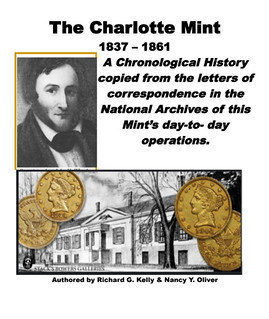 Kelly & Oliver Publish on the Charlotte Mint
Kelly & Oliver Publish on the Charlotte Mint
The Charlotte Mint 1837–1861, by Richard G. Kelly and Nancy Y. Oliver, presents a detailed chronological history of the Charlotte Branch Mint based largely on the original correspondence of Superintendent John H. Wheeler and other officials preserved in the U.S. National Archives. Established by the Act of March 3, 1835, the Charlotte Mint was one of three southern branch mints created to process locally mined gold. The volume traces the Mint's formation, its first bullion deposits in 1837, and the long-delayed start of coinage in March 1838. The authors compile the surviving letters between the Superintendent, Mint Director Robert M. Patterson, and key officers like Coiner John R. Bolton and Assayer Dr. John H. Gibbon, revealing the logistical, mechanical, and administrative struggles that marked its early operations—broken rollers, leaking zinc roofs, acid shortages, and personal disputes.
The treatise proceeds year by year through the Mint's turbulent history—covering fires (notably the devastating 1844 blaze), personnel controversies, coinage production issues, and the final Confederate takeover in 1861, after which Charlotte ceased striking coins and later functioned only as an Assay Office until 1913. The editors highlight significant documents on coinage, die shipments, and production discrepancies to correct or clarify historical mintage figures. Intended as a research donation to the Newman Numismatic Portal, the work acknowledges earlier archival efforts by scholars Roger Burdette and Robert Julian and aims to preserve the first-hand administrative record of one of the most historically significant southern U.S. mints, documenting its challenges, personalities, and eventual decline amid the Civil War.
Images: 1849-C Open Wreath gold dollar, NGC MS63 CAC. Heritage 2015 CSNS sale, lot 5228, realized $493,500.
Link to The Charlotte Mint 1837–1861 on Newman Portal:
https://nnp.wustl.edu/library/book/651780
NUMISMATIC TRICK-OR-TREAT FOR HALLOWEEN
Newman Numismatic Portal Project Coordinator Len Augsburger also compiled the following examples of numismatic Halloween treats. I added a photo of a mystery contemporary numismatist - can anyone guess who this is? Hint: not me. -Editor
Numismatic Trick-or-Treat for Halloween
 As the annual festival of sugar approaches, we review numismatic approaches to dealing with dressed up candy collectors. The November 8, 2015 E-Sylum reported "John Nebel of Colorado collects ancient coins, and on Halloween he offers trick-or-treaters a choice of candy or an ancient coin. Cruel choice, but a fun exercise." Nebel said that many selected "treats" in favor of more valuable coins.
As the annual festival of sugar approaches, we review numismatic approaches to dealing with dressed up candy collectors. The November 8, 2015 E-Sylum reported "John Nebel of Colorado collects ancient coins, and on Halloween he offers trick-or-treaters a choice of candy or an ancient coin. Cruel choice, but a fun exercise." Nebel said that many selected "treats" in favor of more valuable coins.
David Gladfelter noted in the October 22, 2017 E-Sylum "A trick-or-treat idea that has worked well for us for a number of years is to put fright stickers on half dollars and hand them out. Many of the kids have never seen a half dollar before, and ask what they are. The kids are always happy, and so are we. No thrown-out fruit or candy littering our lawn, no parents disapproving of what the kids bring home, and best of all, no left over bags of candy growing stale for us to use up and gag on."
Steve Roach wrote in the October 27, 2008 issue of Coin World "My friend and world coin aficionado Bob Skye used to give out modern, shiny world coins in 2-inch by 2-inch holders, labeled with descriptive information as to their country, date and denomination."
David Menchell, in the Colonial coins Google group, reported "For Halloween, rather than give candy, I have a Halloween coin bowl with foreign coins in 2 X 2 flips. I put a coin in each pocket, so the children get two coins. I try to vary it so there may be a European coin and an Asian coin, for example. I also copied the text from the coins I received from the ANA and printed it on a standard 8 1/2 X 11 sheet, 12 to a page. I print them out on white card stock and use a paper cutter to cut them down to fit the flips. I have a couple of photos to demonstrate. I figure this is a great way to encourage kids to learn about coins, spread the word about the ANA, plus cut down on excess sugar intake. If anyone is interested in giving away Colonial coins, let me know where you live so I can go trick or treating in your neighborhood."
 The Chicago Coin Club Chatter, January 1983, included a satirical piece on the chocolate coin market, which noted market peaks coinciding with Halloween. The article described a 1968 debacle known as Brown Friday: "Texas billionaire Nelson Bunker Hunt had been stockpiling chocolate coins since early 1963 and the value of chocolate coins grew steadily until it hit an all-time high of $55 per ounce on November 2, 1968. But the very next day, Bunker Hunt, in a fit of depression, walked into his vault and ate two-thirds of his chocolate coin portfolio. The effects were catastrophic and sent shock waves across the country." In a similar vein, David Pickup reported in the April 1, 2014 E-Sylum on a fictitious reference work, A Guide to Chocolate Coins, said to be built on earlier studies such as the German work Ein Yarbuch die Chockiekoiningmitderwrappenon.
The Chicago Coin Club Chatter, January 1983, included a satirical piece on the chocolate coin market, which noted market peaks coinciding with Halloween. The article described a 1968 debacle known as Brown Friday: "Texas billionaire Nelson Bunker Hunt had been stockpiling chocolate coins since early 1963 and the value of chocolate coins grew steadily until it hit an all-time high of $55 per ounce on November 2, 1968. But the very next day, Bunker Hunt, in a fit of depression, walked into his vault and ate two-thirds of his chocolate coin portfolio. The effects were catastrophic and sent shock waves across the country." In a similar vein, David Pickup reported in the April 1, 2014 E-Sylum on a fictitious reference work, A Guide to Chocolate Coins, said to be built on earlier studies such as the German work Ein Yarbuch die Chockiekoiningmitderwrappenon.
Link to the Chicago Coin Club Chatter on NNP:
https://nnp.wustl.edu/library/publisherdetail/525556
VIDEO: BRANCH MINT AT DAHLONEGA, GEORGIA
The David Lisot Video Library on the Newman Numismatic Portal can be found at:
https://nnp.wustl.edu/library/multimediadetail/522852
We highlight one of his videos each week in The E-Sylum. Here's one from 2016 with Carl Lester speaking about the Dahlonega Mint. -Editor
Hear the story of the mint in Georgia where some many rare gold coins were created in the early 1800's. Speaker: Carl Lester.
To watch the complete video, see:
US Branch Mint at Dahlonega, Georgia
(https://youtu.be/3yY6PJjbQXg)
US Branch Mint at Dahlonega, Georgia
(https://nnp.wustl.edu/library/book/549137)
NOTES FROM E-SYLUM READERS: NOVEMBER 2, 2025
All the Cents in North Carolina
Regarding MrBeast's video,
Garrett Ziss writes:
"I might be missing something entirely obvious here, but if there aren't 1.2 million cents in all the banks in North Carolina, then where are the billions of cents minted each year going? North Carolina made up about 3.17% of the U.S. population in 2018 (when the "I Bought A Car Using Only Pennies" video was released), which would suggest only 37.85 million cents were available from banks. That is just 0.48% of the 7,803,200,000 combined mintage for Philadelphia and Denver reported in the Red Book for 2018, not to mention the billions of existing cents made before 2018."
Good point, although the cents in the hands of banks are the only readily available ones, and you'd have to travel to every bank in the state to get them. And only Santa Claus could visit every household and hoover up the rest of the cents from every piggy bank and couch cushion in the state. -Editor
To read the earlier E-Sylum article, see:
MRBEAST CASH STUNTS
(https://www.coinbooks.org/v28/esylum_v28n43a27.html)
Alonzo H. Sawyer, Postmaster
In my Numismatic Diary last week, I illustrated a 25 cent Civil War scrip note from Jones and Sawyer in Alton, NH with a postmark on the back. I hadn't encountered a scrip note with a postmark before, and that's what led me to buy the piece. David Gladfelter responded with information about this piece, and noted some others also featuring postmarks. Thank you! -Editor
David writes:
"Alonzo H. Sawyer was the postmaster of Alton during the presidency of Abraham Lincoln. He held that post while also running his dry goods business with Jeremiah Jones.
"Today the job of postmaster is in the civil service, but in 19th century small towns it was often part time. At least two New Jersey scrip notes have postal markings on their backs, put there by postmasters probably to give the notes an official-looking appearance so as to boost public confidence in the notes and facilitate their circulation. A series of fractional scrip notes issued in 1837 by the municipal Corporation of Bordentown in denominations of .0625, .125, .25 and .50 have the circular date stamp ("CDS" to stamp collectors) of postmaster Joshua Carman, who is a named payee on the notes. History does not leave a record of his full time job. The three lower denominations are listed by George Wait in his catalog New Jersey's Money. William H. Howell of Ewingville was proprietor of the Park House there and also the local postmaster. His .10 note has his postmark on the back. Wait lists a .05 denomination by an "unknown issuer" in that town, from an unsigned remainder."
To read the earlier E-Sylum article, see:
WAYNE'S NUMISMATIC DIARY: OCTOBER 26, 2025
(https://www.coinbooks.org/v28/esylum_v28n43a21.html)
The Colonial Coin Club of Pennsylvania
Pete Smith writes:
Last week Roger Moore wanted to know more about the Colonial Coin Club of Penna.
There were a number of Colonial Coin Clubs operating in the 1960's including The Colonial Coin Club of Annapolis, Maryland, (1963-2020) and The Colonial Coin Club of Williamsburg, Virginia, (1961-1969).
 The Colonial Coin Club of Pennsylvania was formed in June of 1962 and became ANA member
club 46620 in September 1962. Founding officers were Alex Kaptick, president; Elmer Storms,
Joseph Diamond, and Michael Curran, vice presidents; Elizabeth Krebs, treasurer; and Charlotte
w. Hindle, secretary. Meetings were held at the Levittown Fire House No. 1.
The Colonial Coin Club of Pennsylvania was formed in June of 1962 and became ANA member
club 46620 in September 1962. Founding officers were Alex Kaptick, president; Elmer Storms,
Joseph Diamond, and Michael Curran, vice presidents; Elizabeth Krebs, treasurer; and Charlotte
w. Hindle, secretary. Meetings were held at the Levittown Fire House No. 1.
There were 83 members present in 1966 when they elected Regina Schneider, president; Herb Kropnick, first vice president; Charles Dawicki, second vice president; Alex Candelton, third vice president; Joe diamond, treasurer; and Frank H, Zachol, secretary.
 The club lacked a consistent identity. The club was also mentioned as the Colonial Coin Club of
Bucks County and the Colonial Coin Club of Levittown. The club was known by its initials,
CCCP. Their T-Shirts are seen around the world.
The club lacked a consistent identity. The club was also mentioned as the Colonial Coin Club of
Bucks County and the Colonial Coin Club of Levittown. The club was known by its initials,
CCCP. Their T-Shirts are seen around the world.
The club issued a bicentennial medal in 1976. They issued wooden nickels for several coin shows up to the 17th annual show in 1980. The club was still meeting in 1988.
They operated somewhat in the shadow of the Colonial Coin Club of Annapolis which lasted longer and also issued wooden nickels.
I dunno about that T-shirt part, but Pete's got a subtle sense of humor. -Editor
To read the earlier E-Sylum article, see:
NOTES FROM E-SYLUM READERS: OCTOBER 26, 2025 : Query: Colonial Coin Club
(https://www.coinbooks.org/v28/esylum_v28n43a09.html)
Mary Wagner's Fancy Turning
Justin Perrault writes:
"The reference to the book Specimens of Fancy Turning was interesting. This made me think of a recent posting by noted currency artist Mark Wagner. He plugged his sister Mary Wagner's art endeavor, which consists of very intricate depictions of spirograph type drawings."
Colorful! Thanks. -Editor
Wagner websites:
https://markwagnerinc.com/
https://www.marywagner.com/shop
To read the earlier E-Sylum article, see:
NOTES FROM E-SYLUM READERS: OCTOBER 26, 2025 :
Book: Specimens of Fancy Turning
(https://www.coinbooks.org/v28/esylum_v28n43a09.html)
$16 Moffat Ingot Buyer Names Sought
Saul Teichman writes:
I am looking for named auction catalogs for the following sales regarding the $16 Moffat ingot.
1) W.E. Woodward's 12/1885 Matthews, Randall & Levick sale, lot 1064.
2) S.H. Chapman's 5/1908 Ashhurst sale, lot 1307.
Any help E-Sylum readers can provide would be greatly appreciated.
Can anyone help? Who were the buyers of these lots? -Editor
Query: The Silver 1909 Peter Cooper Medal
Website visitor
David Holcomb writes:
"I read your article titled "TWO NUMISMATIC RESEARCHERS AT TIFFANY'S" and enjoyed it.
"I was wondering if you could help me find some information about a medal our family has. It is the 1909 Peter Cooper medal. Everywhere I look I find the bronze version in a round case. The family medal is made out of fine silver and is in a presentation box. We believe the medal was given either to James Maginn or his second wife Mary Peoli Maginn. James worked at Cooper Union and was a friend of Peter Cooper and actually took Lincoln around upon Lincoln's visit to the Cooper Union. Mary Peoli Maginn also worked at the Cooper Union and was friends with Peter Cooper's daughters.
"We would love to learn more about this special medal in silver. How many silver medals were produced or who were they given out to are questions that come to mind. Can you direct us to a book that might have more info? The image below is what we have found so far.
Thanks for your time, Dave and MaryAnne Holcomb, MaryAnne is the great grand niece of Mary Peoli Maginn."
Well, an earlier issue of the American Journal of Numismatics (Vol 45, July 1911, page 162) noted that George Kunz presented to the Society "two specimens, one in silver and one in bronze, of the Peter Cooper medal by Roty." So the American Numismatic Society likely has a silver one, although I was unable to locate it in their catalogue. This item is listed as a bronze, but it does look silvery in the photo. -Editor
To read the ANS collection entry, see:
Bronze Medal, France. 1959.148.41
(https://numismatics.org/collection/1959.148.41)
Can anyone help? Has the number of silver medals made been documented anywhere? -Editor
To read the earlier E-Sylum article, see:
TWO NUMISMATIC RESEARCHERS AT TIFFANY'S
(https://www.coinbooks.org/esylum_v08n48a07.html)
U.S. Mint Director Philip Diehl Interview
Ron Guth passed along this video of Mike Rowe interviewing former U.S. Mint Director, Philip Diehl. Thanks! It's lengthy but interesting. The linked webpage has a table of contents including Rapidly transforming the U.S. Mint, Creating the Sacagawea and state coins, and Why the Susan B. Anthony coin failed. -Editor
To watch the video, see:
Dirty Truth About The U.S. Mint & The Coin We Couldn't Make | Philip Diehl #455 | The Way I Heard It
(https://www.youtube.com/watch?v=Sl0tP7AB96Q)
Museum Theft Cartoon
Loren Gatch writes:
"I have no particular insight about the Louvre theft, other than to sympathize with the French, as this embarrassment just piles up on top of their other (political) woes. I did run across the attached cartoon which, I think, does justice to the mood. Indeed, this might actually be a panel from an old "Tintin" comic album. I used to read them as a kid, but don't remember now where this picture might have come from."
Thanks. I don't know French, but Google Translate reveals the dialogue:
Me? I didn't see anything
I did, they left that way
-Editor
To read the earlier E-Sylum article, see:
FRENCH MUSEUM THEFTS
(https://www.coinbooks.org/v28/esylum_v28n43a26.html)
VOCABULARY TERM: SAND CAST, SAND CASTING
Here's another entry from Dick Johnson's Encyclopedia of Coin and Medal Terminology. -Editor
Sand Cast, Sand Casting. The casting, or making a cast in a mold made of sand. Because sand casts typically have porous and uneven surfaces they are not suitable for coin models but can be ideal for making medals where a somewhat grainy surface is desired. Sand casts are usually large medallic items, as plaques or foundry cast patterns. An example was the Special Medal of Honor of the National Sculpture Society, where artist Laura Gardin Fraser wanted a more typical sculptural treatment for the glyptic field's highest award medal.
How a sand casting is made. This is a very old method of metalcasting, however for art casting it is also called the French sand process. Dry sand is mixed with water and this is called green sand. Green sand is used because it can be packed tight and holds together due to the affinity of water between the grains of sand.
The mold is made around the pattern by packing green sand as tightly as possible (this is accomplished with fingers and a wooden tool called a bench rammer). Uniface plaques and single sided patterns can be made in an open mold. Such a mold does not have a top on the flask which holds the green sand in place while the mold is made and the metal is poured. (A diagnostic of an open mold casting would be a reverse with a lightly rippled surface and a slight meniscus at the edge, forming a rounded raised rim.)
To obtain a two-sided casting, or a casting with a core, a bed in the drag (bottom half of the flask) is filled with green sand. The pattern is placed in position, to extend half above the top and it too is packed with green sand. The sand is somewhat bonded because of the water, it is retained in the cope as it is separated from the drag and the pattern carefully removed.
Channels are cut in the green sand, gates, sprues and vents for the metal to enter the cavity and air to escape. The cope is placed back over the drag and clamped together to resist the pressure of the molten metal as it flows into the cavity. Once the flask is ready and the metal heated to the proper temperature, the pour, pouring inserts the molten metal through the sprues into the mold cavity.
The casting is allowed to cool, after which the flask is removed and the sand is broken away from the casting. It is cleaned and ready to have the metal that filled the gates, sprues and vents removed by cutting and grinding smooth. There will be a parting line where the cope and the drag came together; this along with any other surface imperfections will have to be smoothed out by chasing.
The metal at this stage is as-cast, bright and untoned. The surface will have to be treated in some way to prevent rust (for iron castings) or toning (for copper and bronze castings). The metal surface is given a finish to prevent toning and corrosion, and for aesthetic coloring if it is an art object. See finish and finishing.
Sand casting is the oldest form of metalcasting. It is one of several current methods of casting, the others include diecasting, precision casting (with lost-wax, also known as investment casting), ceramic mold and shell mold, and also permanent mold casting.
To read the complete entry on the Newman Numismatic Portal, see:
Sand Cast, Sand Casting
(https://nnp.wustl.edu/library/dictionarydetail/516697)
ALPHONSE ANTON KOLB (1893-1983)
E-Sylum Feature Writer and American Numismatic Biographies author Pete Smith submitted this article on medalist Alphonse Kolb. Thanks! -Editor
I have about fifty medals struck from dies produced by Alphonse Kolb. He is known for producing dies for the presidents of the Rochester Numismatic Association. One of those was for Kolb himself.
Kolb was born in Waldsteffen, Gmund, Germany on December 5, 1893. He was the son of Karl Kolb and Mary Kinle. He was an apprentice at a jewelry company at age fifteen and studied art and sculpture in Munich and the Hamberg Art Institute.
Alphonse married Elfrieda L. Reichelt (1877-1945) on September 4, 1918. At the time, he was 25 and she was 41. His second marriage was to Kathryn Yohann Kolb (1887-1968).
Much of his story was in his obituary in the Rochester Democrat and Chronicle for March 31, 1983.
Kolb joined the Rochester Numismatic Association on November 14, 1922. He joined the American Numismatic Association on June 1, 1923, as member 2528 from his home at 453 Clinton Avenue in Rochester, New York. He converted to life membership in February 1949. as LM 228 from 120 Collingwood Drive and remained a member for 59 years. His collecting interests focused on medals.
 The Rochester Numismatic Association had a series of presidential medals by Joseph A. Koeb, a
charter member of the RNA. He produced the first nine presidential medals for the club.
The Rochester Numismatic Association had a series of presidential medals by Joseph A. Koeb, a
charter member of the RNA. He produced the first nine presidential medals for the club.
Alphonse A. Kolb began his series of presidential medals with the 1921 medal for Woolf H. Amberg. Kolb was club president in 1931 and received one of his medals. After fifty-six years, the series ended with the medal for Willian Coe in 1977. Has any other medalist exceeded this record?
Kolb did a medal for the 500th meeting of the club in 1934, the 700th meeting in 1943 and the 1000th meeting in 1958. He did a dollar-size medal for the fiftieth anniversary of the club in 1962. He also did medals for the 25th, 35th, 60th and 70th anniversaries.
Kolb worked with Koeb on the 1917 medal for the ANA Convention badge. Kolb did the 1928 ANA convention badge. He did the ANA badge again in 1947. He did medals for the 20th anniversary of the Buffalo Numismatic Association in 1947.
For the RNA presidential medals, Kolb cut the image directly in the steel die. For his large plaques, he sculpted in clay for the plaques to be cast in bronze.
I was surprised to learn that Kolb did the dies for the George J. Bauer personal medal. This features an obverse based on a Syracuse decadrachm.
He died in Rochester on March 30, 1983, and is buried with Elfreda at Mount Hope Cemetery in Rochester. Kathryn is in a different section of the same cemetery. The headstones of both women have bronze plaques sculpted by Kolb.
To learn more and see photos of many of his plaques see The TAMS Journal for August 1973 and a TAMS special issue, "Alphonse A. Kolb. M. A. The Man and his Works" by Charles J. Ricard.
MINT'S DIRECTOR NOMINEE PAUL HOLLIS TESTIFIES
Dennis Tucker submitted this article about Paul Hollis's Senate hearing this past Thursday. Thank you! -Editor
Today was a big day for American coins and medals—and for the office of the Director of the United States Mint. At 10:00 this morning, in the Dirksen Senate Office Building, several presidential nominees met for statements and questioning before the Committee on Banking, Housing, and Urban Affairs. Among them was Mr. Paul Hollis of Louisiana, the first longtime numismatist ever to be nominated as the Mint's Director.
Every modern Mint Director has spoken publicly of a personal interest in coins. But Paul Hollis has actually collected and studied coins since childhood, and has been a member of the American Numismatic Association for decades. He's an active participant in both the "hobby" side and the "market" side of coins.
In his testimony Hollis told the assembled Senators, "One of my earliest and most vivid memories dates back to when I was just seven years old. My grandmother gave me a coin that she had saved during the Great Depression. That small gesture left a lasting impression that quietly steered the course of my life. Today, I keep the coin that she gave me nearly a half-century ago as a tribute to her. I have kept the coin in my pocket at every important milestone in my life. And of course, it is here with me today, along with the catalog of coins that I made when I was just eight years old."
Those of us who know the United States Mint will sometimes wink and smile when we hear Director nominees say such things. Every one of them pulls out a story of a coin given to them long ago by a family member. But Paul Hollis put his money where his mouth is. Recalling his childhood, he told the Senators, "While my classmates would give oral reports on Babe Ruth and Amelia Earhart, I would speak about David Rittenhouse—the first Director of the United States Mint back in 1792."
Hollis described his career in numismatics, including volunteering as an educator and writing a book on the history of American coinage. Beyond numismatics, he told the Committee about his experience in Louisiana's state legislature and election to its State Board of Education. This has given him the background to, as he put it, "unify diverse voices, navigate complex systems, and deliver results within tight guidelines and timelines."
He also noted the importance of coinage in the upcoming 2026 national Semiquincentennial. "It is vital that we have a passionate ambassador for both our circulating coinage as well as our commemorative issues," he said. "My passion and experience that spans many decades has equipped me to energize audiences, share the captivating stories behind our coinage, and promote new designs with enthusiasm and vision."
Will Paul Hollis successfully lead the United States Mint through this significant era of American coinage? He sees his life as being a path leading inevitably toward directing the Mint. "My journey has led me to this role," he told the Senate Committee. "And, if confirmed, I will be truly honored to serve."
THE COMMITTEE'S QUESTIONING
Traditionally in Senate confirmation hearings, Mint Director nominees don't get mercilessly grilled and don't field a lot of hardball questions. This was the case in Paul Hollis's hearing this morning.
Most of the Committee's questioning was directed to Mr. Travis Hill, nominee for the chair of the FDIC Board of Directors; Mr. Francis Cassidy, to be Assistant Secretary of the Department of Housing and Urban Development; and Mr. Joseph Gormley, to be President of HUD's Government National Mortgage Association.
Senator John N. Kennedy of Louisiana greeted the Mint nominee warmly. "Mr. Paul Hollis, I've known him for a long time. He is a favored son in Louisiana. He served honorably and admirably in our state legislature. He was on the board of elementary and secondary education. There's no more important job in my state. There is nobody in this country who knows more about coins and coinage and numismatics than Paul Hollis, and all of us in Louisiana are so proud of him."
Senator Christopher Van Hollen of Maryland asked about the prohibition of coins with a portrait of a living person. Hollis confirmed he was familiar with the issue. Van Hollen noted the law was meant to avoid currency becoming a vehicle of aggrandizement or "self-honoring," to avoid the appearance of a monarchy, and to maintain the dignity of our currency by not showing living figures who might be "controversial, subject to change, or still actively involved in public life." He questioned Hollis on whether the recently proposed dollar coin design depicting President Donald Trump would violate the law. Hollis assured the Senator that his background of thirty years as a professional numismatist, and his career in elected office having been professional and of high integrity, guarantee that he will always be in compliance with the law. Questioned further, he affirmed he would "be more ears than mouth" and would seek legal advice on all such questions.
Asked by Senator Van Hollen about the Harriet Tubman portrait proposed for the twenty-dollar bill, Hollis respectfully referred him to the Bureau of Engraving and Printing. The BEP, not the Mint, has jurisdiction over paper currency. Van Hollen asked that Hollis, as part of "that ecosystem," do anything he can "to push that forward."
Senator Catherine Cortez Masto of Nevada remarked on her own work on the law that created the American Women quarters and Semiquincentennial circulating coins. She noted that it was never the legislation's intent that the current president in 2026 would be featured on a circulating coin, and voiced her concern about the proposed Trump dollar. Hollis reassured her that "If confirmed as Director of the United States Mint, I will always seek legal counsel and am always 100 percent committed to following the law."
LEADERSHIP OF THE MINT WILL SOON BE DECIDED
 If the Senate Committee has any more questions for Paul Hollis or other nominees, they will be submitted by 12 noon tomorrow (Friday, October 31, 2025). Nominees will then have until 5:00 pm Monday, November 3, to submit their answers to facilitate the Committee's vote on their nomination.
If the Senate Committee has any more questions for Paul Hollis or other nominees, they will be submitted by 12 noon tomorrow (Friday, October 31, 2025). Nominees will then have until 5:00 pm Monday, November 3, to submit their answers to facilitate the Committee's vote on their nomination.
On a personal note, the warmth, love, and pride Paul Hollis feels for his family was on full display in his Senate confirmation hearing. He spoke of his daughter Bree (a straight-A senior at the University of Alabama) and son Zachary (also a straight-A student, and vice president of his student body). They were visible seated behind him, along with his two brothers and other friends and associates.
I have a copy of Paul Hollis's book, American Numismatist, in my office library. I look forward to a longtime professional numismatist and published author taking on this important Treasury Department role. Paul Hollis's name will be highlighted in many more history books from this point forward—as the forty-first Director of the United States Mint.
Coinweek interview with Hollis about his book
John Feigenbaum also attended the event and published this Greysheet article. We're republishing it here with permission. Thank you! -Editor
On Thursday, October 30, Paul Hollis, of Louisiana, was called before the United States Senate Banking, Housing, and Urban Affairs committee to answer questions from committee members consisting of Senators from 24 different states. SD Bullion posted a compilation video on Youtube.
The hearing, which included Mr. Hollis and three other Presidential appointees, lasted about two hours, and much of the Senators' focus was aimed to other candidates. Based on the line of questioning, Hollis would appear to be in unanimous favor with the committee, though it was suggested by Chairman Tim Scott (R - SC) that much of the final voting is expected to go down party lines.
Mr. Hollis was grilled a few times on the matter of a circulating coin bearing President Trump's likeness being minted. Each time, Hollis responded that he would faithfully acquit his job as United States Mint Director with utmost adherence to the 1866 law, and that he could otherwise not comment on the specifics of the design in question. This was the perfect answer to such an impossible question.
April 7, 1866 - An Act of Congress stated that only a portrait of a deceased person could appear on currency. The Act was caused by an uproar over the actions of the Chief of the Bureau of Engraving and Printing, Spencer Clark. Clark placed himself on a five cent note and had a large quantity of them printed before it was noticed. Due to Clark's actions the already prepared 15 cent note featuring Sherman and Grant was never released.
The role of Mint Director is to produce coinage at the behest of the Treasury Department, and an appointee would have no knowledge of the veracity of a design that has not been formally proposed. As it turns out the law is murky on this subject and coins are not specifically mentioned. Regardless, Hollis handled the questions with a straightforward and steadfast response that appeared to put the Senators at ease.
Beyond that, Mr. Hollis received adulation from his fellow Louisiana compatriots including Senator John Kennedy (R - LA), who referred to him as a "favored son in Louisiana."

Senator John Kennedy (R - LA, left) takes a moment to speak with Paul's family before the hearing. (Photo courtesy of Jerry Jordan)
Next steps for Mr. Hollis will come in when the committee votes to approve the appointees -- presumably in the next few weeks, and then final confirmation of the Senate. As an attendee of the event yesterday, I was humbled by the machine of democracy at work, even while the government is shut down. The Senators made some use of their time to make general political statements but I was heartened by the fact that the Senators and Appointees in the room are devoted civil servants with the best of intentions to carry on the work of the American people. I rarely, if ever, make political statements because I feel such matters are personal and the right of each person. However, I was in awe of everyone in the room yesterday, and I felt a pang of guilt that I have never performed public service in this way.
Speaking for myself and the Whitman team, we are full supporters of Paul Hollis. We are extremely proud that "one of our own" could carry the mantle as next United States Mint Director. Hollis' appointment will mean we have a true advocate at the Mint with real knowledge of our hobby.

The "coin crew" stands together, after the hearing. From left to right: Jerry Jordan, Paul Hollis, Dan Duncan, John Feigenbaum.
Hollis has an eye for paper money, too. John sent this previously unpublished photo of the same coin crew in a nearby Senate office, where Hollis is holding what may be proofs of the $100,000 bill. -Editor
To read the complete article, see:
Paul Hollis Testifies Before Senate Banking Committee on Route to Mint Director Position
(https://www.greysheet.com/news/story?title=paul-hollis-testifies-before-sentate-banking-committee-on-route-to-mint-director-position)
To read earlier E-Sylum articles, see:
NEW BOOK: AMERICAN NUMISMATIST
(https://www.coinbooks.org/esylum_v14n51a03.html)
PAUL HOLLIS NOMINATED FOR U.S. MINT DIRECTOR
(https://www.coinbooks.org/v28/esylum_v28n29a18.html)
I had a chance to briefly meet Paul Hollis at the ANA in Oklahoma City, and wish him the best of luck. See his Wikipedia article for more background - I wasn't aware that he'd "joined the Odyssey Marine Exploration to salvage coins from the SS Republic." -Editor
To read the complete Wikipedia article, see:
Paul Hollis
(https://en.wikipedia.org/wiki/Paul_Hollis)
MSNS FALL 2025 CONVENTION SPEAKERS
The Michigan State Numismatic Society has a nice lineup of speakers for their upcoming fall convention. -Editor
NOVEMBER 14-16, 2025
 11:00 a.m. Meeting room Tim Coleman, speaker
11:00 a.m. Meeting room Tim Coleman, speaker
The History of Canadian Coinage
This presentation will focus on how trade & acquiring goods evolved as European Explorers arrived in Northern America. The changes that occurred as non-indigenous people from various countries influenced coinage as the developing provinces came together forming a country.
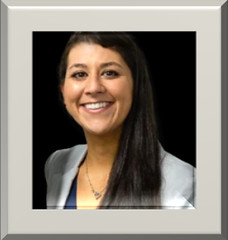 2:00 p.m. Meeting room Bianca Bart, speaker
2:00 p.m. Meeting room Bianca Bart, speaker
U.S. Paper Money Errors: Understanding +
Identifying Genuine vs. Altered Examples
Are you fascinated by the strange and unusual? Ever wonder how our paper money is printed—or how things go hilariously wrong inside the Bureau of Engraving and Printing? Join U.S. paper money expert and professional numismatist Bianca Bart of Executive Currency for an engaging, interactive presentation all about genuine U.S. paper money errors—and how to spot the real ones vs. man-made fakes. Whether you're a curious beginner, seasoned collector, young numismatist, or just love a good money mystery, this event is for you!
Bianca is the co-author of the brand-new 5th edition of United States Paper Money Errors (released Aug. 2025) and a 2025 Coin World "100 Most Influential People in Numismatics" honoree. She brings big energy and even bigger knowledge to this hands-on session—plus a fun quiz, prizes, and a chance to win a signed copy of her latest book! Join Bianca Bart and other error enthusiasts on Friday, Nov. 14 at 2pm.
 4:00 p.m. Meeting room
4:00 p.m. Meeting room
Mich-TAMS annual meeting
Join fellow Mich-TAMS old and new members for their annual meeting (celebrating 60 years of existence) where several important items are to be discussed, including a new name for the newly organized group of both Mich-TAMS and Paper Money Collectors of Michigan members.
 11:30 a.m.-1 p.m. Meeting Room
11:30 a.m.-1 p.m. Meeting Room
YN Luncheon and Auction
Join our Young Numismatist staff as they educate, feed (pizza of course) and host an auction for all kids and their families! Plan to be suitably surprised at how much you will learn while having fun!
 2:00 p.m.-2:45 p.m. Meeting Room
2:00 p.m.-2:45 p.m. Meeting Room
Mark Wieclaw- Time Travel through Numismatics
Join Mark Wieclaw, an officer of the Chicago Coin Club and a great speaker from the state of Illinois, as he shares the story of the first coin ever made 7th century BC, and then continues to talk about interesting or historical coins, tokens, and medals through the 21st century
 3:00 p.m. – 3:45 p.m. Meeting room
3:00 p.m. – 3:45 p.m. Meeting room
Mark Benvenuto – How To Create An Art Medal Easily
Join U of Detroit-Mercy chemistry professor (and a member of the MSNS board) Mark Benvenuto as he demonstrates how to create an art medal using a process he uses with his students! Mark will share the process with all attendees and then give you all handouts and show you some sample medals!
For more information on the show, see:
https://michigancoinclub.org/
ATLAS NUMISMATICS SELECTIONS: NOVEMBER 2, 2025
Atlas Numismatics has updated their website with 596 new coins, medals, and tokens at fixed prices. Select items are discussed below. -Garrett
1084994 | GREEK. CALABRIA. Tarentum (Taras). Struck circa 280-272 BC. AR Didrachm. NGC Ch. XF? (Choice Extremely Fine ?) Strike 5/5 Surface 5/5. 7.73gm. Naked ephebe on pacing horse left, crowning horse's head with wreath; SA to right; ???-TO? in two lines below / ????S. Youthful oikist, nude, riding dolphin to left, holding a tripod in his outstretched right hand and resting his left on the dolphin; below, ??S. HN III 957; Vlasto 666.
Beautifully toned and struck on an exceptionally broad, full planchet. Given the star designation by NGC for exceptional eye appeal.
$3,695
To read the complete item description, see:
Beautifully Toned Tarentum Didrachm
(https://atlasnumismatics.com/1084994/)
1082813 | AUSTRIA. Ferdinand I. MDCCCXXX (1830) AV Medallic Ducat. PCGS MS66. Vienna. 20mm. 3.49gm. FRANC.I.ET. PER EVM FERB. V. Laureate bust and bare head, conjoined, to right / CORONB.POSN./ MENSE SEPT/ (date). Radiant crown above legend; date in Roman numerals below. Novák XVIII-A-4a; Huszar 924; Hauser 4; Montenuovo 2517; Wurzbach 2056. For the Coronation of the Hungarian King in Pressburg.
$14,950
To read the complete item description, see:
Superb Ferdinand I Coronation Ducat
(https://atlasnumismatics.com/1082813/)
1084585 | GREAT BRITAIN. Victoria. (Queen, 1837-1901). 1887 AV Model Gothic Half Farthing. NGC PR64 Cameo. London. 3.05gm. VICTORIA – QUEEN & EMPR. Gothic bust, left; date below truncation / •*• JUBILEE MODEL •*• HALF FARTHING. St. George on horseback slaying the dragon. Unlisted in KM-X; Unlisted in Peck. Privately issued as a pattern or 'model' striking and in commemoration of the Queen's Jubilee.
$19,500
To read the complete item description, see:
Gold Model Half Farthing
(https://atlasnumismatics.com/1084585/)
1083482 | ITALIAN STATES. Tuscany. Ferdinand I de' Medici. (Grand Duke, 1541-1587). 1594 AR Piastra. PCGS MS63. 43mm. 32.61gm. FERDINANDVS. MED. MAGN. DVX. ETRVR - IÆ. III. Armored bust, right / *FILIVS. MEVS. - .DILECTVS.*. St. John performing the baptism of Jesus Christ in the river Jordan; dove of the holy spirit above. Dav.-8389; MIR.224/7.
$6,750
To read the complete item description, see:
Choice Ferdinand I de' Medici Piastra
(https://atlasnumismatics.com/1083482/)
1084181 | NETHERLANDS. Holland. 1792/1 AR Ducaton, Silver Rider. PCGS MS65. Edge: Reeded. BELG : PRO : HOL : MO : NO : ARG : CON FOE :. Armored Knight on horse holding sword above head, crowned arms below / CONCORDIA RES PAR... Crowned arms of Holland, with supporters, date in cartouche below. KM 90.2; Dav.-1827.
$22,500
To read the complete item description, see:
Gem Holland Ducaton or Rider
(https://atlasnumismatics.com/1084181/)
1084385 | SWISS CANTONS. Zurich. 1776 AR Thaler. PCGS MS65. MONETA REIPUBLICÆ TURICENSIS ·. Oval arms of Zurich with palm branch at left, supported by rampant lion at right / IUSTITIA/ET/CONCORDIA, date above crossed cornucopias within ornate cartouche. KM 163; Dav.-1794; HMZ 21164.
$6,950
To read the complete item description, see:
Exceptional Zürich Thaler
(https://atlasnumismatics.com/1084385/)
Updates to their online inventory are issued monthly.
For more information and to sign up for the firm's monthly newsletter, visit:
atlasnumismatics.com.
DOYLE NOVEMBER 4, 2025 WASHINGTONIA SALE
Doyle is auctioning a group of Washington medals in their November 4, 2025 sale. Here's an article written by Chris Bulfinch, Appraiser and Specialist of Coins, Stamps, Currency and Collectibles. -Editor
George Washington's well-documented aversion to representation on currency notwithstanding, a life as consequential as his inevitably earned monetary and medallic plaudits. Even before he was first featured on Treasury Notes in the 1840s and Federally-issued circulating U.S. currency in the 1860s (which would have chagrined him), Washington appeared on medals and tokens within his lifetime. Some tokens and medals depicting him are exceedingly rare, even unique, others are quite common. His likeness even appeared on Civil War dog tags and currency issued by the Confederacy, as both sides invoked his image and revered persona in support of their respective causes.
Some collectors of U.S. tokens and medals (material broadly defined as "exonumia") choose to focus on depictions of Washington, and prominent numismatists and researchers have made efforts to catalog medallic appearances of the First President. Numerous such efforts have been attempted since the nineteenth century, notably U.S. Mint Director James Ross Snowden's A Description of the Medal of Washington; of National and Miscellaneous Medals published in 1861, covering mainly Washington medals in the Mint's own cabinet. William Spohn Baker's 1885 Medallic Portraits of Washington is a widely-lauded work on the topic; original copies were voted the 49th most desirable piece of numismatic literature by the membership of the Numismatic Bibliomania Society in 2007. George Fuld and Russell Rulau, two of the last century's foremost experts on American exonumia, published two expansions of Baker's work in the 1980s (a centennial edition) and 1990s; Fuld published an expansion of Baker on his own in 1965. Neil Musante's two-volume 2016 work Medallic Washington is a must-own for collectors of numismatic Washingtonia. Many of the finest minds in American numismatics have dedicated some part of their research efforts to cataloging as comprehensively as possible medallic depictions of Washington, and some of the finest collectors of American coins, tokens, medals, and paper money have built sophisticated collections of such material.
Doyle's November 4, 2025 auction includes several notable Washington medals. The marquee item is an original bronze "Washington Before Boston" Comitia Americana medal. Jean-Antoine Houdon's famous bust of Washington served as the basis for this design and the obverse of the "Fill Blessed Sun" medal, discussed below, and many other medallic depictions of Washington, including John Flanagan's design, which appeared on the obverse of the Washington quarter from 1932 to 2021, probably the version of the bust most familiar to the numismatically-uninitiated.
The Comitia Americana "Washington Before Boston" medal honored Washington's March 1776 recapture of Boston, the first commemorative medal authorized by the Continental Congress. Its reverse depicts Washington and officers observing the British evacuation from their fortified positions on Dorchester Heights. Both the obverse and reverse designs have been restruck and reproduced countless times over the nearly two-and-a-half centuries since the medals debuted, making it one of the most recognizable of all early American medals; indeed, an example of the Washington Before Boston medal holds the number two ranking in Q. David Bowers' 2007 book 100 Greatest Medals and Tokens (Lot 5).
Washington appears in distinctive military garb on the obverses of two different versions of the 1805 Eccleston medal included in our sale. A large bronze medal with a high-relief portrait of Washington in full military regalia and armor commissioned in 1805 by Daniel Eccleston, a British Quaker radical whose travels in North America in the years leading up to the American Revolution included a meeting with Washington. The medal's reverse text recognizes Washington's many achievements, with an Indigenous man flanked by text reading "THE LAND WAS OURS," complicating the medal's celebration of our country's first Chief Executive. One of the medals included in the sale is an original (Lot 6) while the other is a cast of a late die state example surrounded by a thick bronze band. Measuring 112mm in diameter and weighing in at over one and a half pounds, this piece of numismatic Washingtonia is far rarer than the medal from which its central device is based (Lot 7).
A mid-19th century restrike of the c. 1806 "Sansom" medal lauds Washington's voluntary relinquishing of the Presidency in 1797 with classical imagery. A haughty bust of Washington appears on the obverse. Restrikes of this medal were produced into the twentieth century, underscoring the popularity of medals depicting Washington as coin collecting exploded in popularity across the United States (Lot 8).
An 1853-dated white metal "Fill Blessed Sun" medal takes inspiration from Revolution-era paper money, casting Washington as the sun at the center of a constellation of stars and thirteen interlocking rings, representing the colonies united. The medal bears a Houdon-based bust of Washington regarded by specialists as among the greatest ever to grace an American medal. It was likely produced after its stated date, purportedly the personal specimen of Charles Ira Bushnell, the nineteenth century numismatist who commissioned the medal (Lot 9).
Rounding out our medallic portrait gallery is a centennial medal with an absolutely beautiful reverse design in which Washington's likeness is one device among many. This gilt "Danish Medal" was struck and issued for the Centennial Exposition that took place in Philadelphia in 1876. Medallic depictions of Washington from this event are many -- readers are encouraged to read Musante's or Fuld and Rulau's catalogs to get a sense of just how diverse the range of tokens and medals is -- but the Danish Medal is among the most beautiful. Washington's likeness appears encircled by a wreath, flanked by cherubs holding a halo of thirteen stars, above a heraldic eagle clutching arrows, an olive branch, and a banner with our nation's motto "E. PLURIBUS UNUM" in its talons. Its obverse features allegorical representations of five females, Columbia (representing the United States) with a cap in the center presenting wreaths to figures representing Art and Mechanics on the viewer's left and Commerce and Agriculture on the viewer's right. The gilt version is less common than its ungilded counterparts (Lot 10).
These half-dozen medals offer diverse visions of Washington that, taken together, demonstrate not only the many roles he took on over the course of his life and the many meanings his life had to his countrymen, but the reverence felt for him by succeeding generations of Americans and people around the world.
To read the complete article, see:
Numismatic Washingtonia
(https://www.doyle.com/story/numismatic-washingtonia/?pc=29)
For more information, or to bid, see:
Coins, Medals & Sports Memorabilia
(https://www.doyle.com/auction/25cs03-coins-medals--sports-memorabilia/?au=9109)
STACK'S BOWERS: RICHARD AUGUST COLLECTION
Stack's Bowers will be selling the Richard August Collection on November 10. Select Colonial & Early American Highlights are discussed below. -Garrett
1652 Pine Tree Shilling. Large Planchet. Noe-1, Salmon 1-A, W-690. Rarity-2. Pellets at Trunk. AU-55 (PCGS). The iconic Noe-1 Pine Tree shilling is regarded as the quintessential type coin in the Massachusetts Bay Colony silver series. These pieces were the first struck for those British colonies that would eventually become part of the United States. They are also among the few American colonial issues struck in silver. Produced to an uncommonly high standard of quality, and relatively plentiful by Massachusetts silver standards, the Noe-1 Pine Tree is a perennial favorite among both colonial type collectors and series specialists. This is an attractive and inviting specimen at the Choice AU grade level that is worthy of strong bids.
To read the complete item description, see:
1652 Pine Tree Shilling. Large Planchet. Noe-1, Salmon 1-A, W-690. Rarity-2. Pellets at Trunk. AU-55 (PCGS).
(https://auctions.stacksbowers.com/lots/view/3-1MZZUY/1652-pine-tree-shilling-large-planchet-noe-1-salmon-1-a-w-690-rarity-2-pellets-at-trunk-au-55-pcgs)
Undated (1659) Lord Baltimore Sixpence. Hodder 2-C, W-1060. Rarity-5. Small Bust, No Stop. Silver. EF-45 (PCGS). Choice and original Lord Baltimore sixpence such as this are highly elusive, a fact that the discovery of 19 pieces in a single English hoard in 2002 did little to change. Few of those pieces showed this kind of strike, most were wiped or cleaned, and none showed this sort of richly original toning. At least one example of this type has been recovered in the ground in North America (in southern Virginia), and many are well circulated, definitive proof that this type achieved its purpose of colonial American circulation in the 17th century.
Purchased from Anthony Terranova.
To read the complete item description, see:
Undated (1659) Lord Baltimore Sixpence. Hodder 2-C, W-1060. Rarity-5. Small Bust, No Stop. Silver. EF-45 (PCGS).
(https://auctions.stacksbowers.com/lots/view/3-1N00CG/undated-1659-lord-baltimore-sixpence-hodder-2-c-w-1060-rarity-5-small-bust-no-stop-silver-ef-45-pcgs)
1722 Wood's Hibernia Farthing. Martin 1.1-A.1, W-12200. Rarity-5. D: G: REX, Harp Left. MS-65 BN (PCGS). Syd Martin's 2007 census, published in his reference The Hibernia Coinage of William Wood (1722-1724), lists only eight examples of this die pairing traced in major collections, including the Norweb-August coin offered here. We have handled a total of six in Mint State: this one; the spectacular Ted L. Craige specimen in PCGS MS-65 BN that brought $21,150 in our March 2013 Baltimore Auction; the Robison-Archangel coin in PCGS MS-63 BN that realized $19,200 in our October 2018 Baltimore Auction; and the two Ford VII coins from our (Stack's) January 2005 sale, one cataloged as "Gem Uncirculated, Prooflike," the other as "Uncirculated, or slightly finer." The Roper-E Pluribus Unum coin is also technically Mint State, but was certified Unc Details--Tooled by PCGS when offered in our November 2020 sale of the latter collection.
The Archangel cataloger described the Craige specimen as "probably finest known," but the Norweb-August specimen is also a strong contender for that coveted title. In any event this is a landmark example of a celebrated type. It is a highlight of the Wood's coinage in Mr. August's collection, and will be a highlight in the next cabinet in which it is included.
Norweb Collection, Part III, Bowers and Merena's, November 1988, lot 3422.
To read the complete item description, see:
1722 Wood's Hibernia Farthing. Martin 1.1-A.1, W-12200. Rarity-5. D: G: REX, Harp Left. MS-65 BN (PCGS).
(https://auctions.stacksbowers.com/lots/view/3-1N00OJ/1722-woods-hibernia-farthing-martin-11-a1-w-12200-rarity-5-d-g-rex-harp-left-ms-65-bn-pcgs)
1785 Nova Constellatio Copper. Crosby 3-B, W-1895. Rarity-2. CONSTELLATIO, Pointed Rays, Large Date. MS-65 BN (PCGS). 108.2 grains. Extraordinary quality and eye appeal for the type, issue, and die pairing, this is the finest certified 1785 Crosby 3-B that has come to auction. Syd Martin's is a PCGS MS-63 BN, Eric Newman's (sold by Heritage) was certified MS-64 BN by NGC, and so on.
ex L. Charney.
To read the complete item description, see:
1785 Nova Constellatio Copper. Crosby 3-B, W-1895. Rarity-2. CONSTELLATIO, Pointed Rays, Large Date. MS-65 BN (PCGS).
(https://auctions.stacksbowers.com/lots/view/3-1N01I7/1785-nova-constellatio-copper-crosby-3-b-w-1895-rarity-2-constellatio-pointed-rays-large-date-ms-65-bn-pcgs)
1787 Massachusetts Cent. Ryder 5-I, W-6130. Rarity-7+. Stout Indian, Arrows In Left Talon. Fine-15 (PCGS). There is not a collection of state coppers that exists today, or at any point in the past, that would not have been improved by this coin. Its status as a Machin's Mills production ties it into a manufactory whose history is relevant to collectors of Connecticut and New Jersey coppers, in addition to the counterfeit halfpence and elusive patterns struck in the shack on Orange Pond. Gary Trudgen suggests in "So-Called Counterfeit Massachusetts Cents" (C4 Newsletter, Summer 2024) that this die marriage and its brethren may have been patterns struck for a coining proposal rather than purely profit-motivated counterfeits. That idea makes a great deal of sense for Ryder 7-H, whose survivors often show impressively smooth edges and whose census includes a number of high grade survivors. For this variety, it strikes us as unlikely, though not impossible. This obverse is also numbered as Ryder's Obverse 14, a 1788-dated counterfeit that couldn't have been a pattern. We suspect this variety and that one were struck at essentially the same time, and that the 1788-dated reverse was made after this one failed early from its fatal cracks.
There may be no more interesting issue in this entire series. The 1787 Ryder 5-I is a rarity without compare, one that deserves to stand with the most distinctive trophies of the other state copper series. This example, though known for decades, does not appear to have ever sold publicly before now.
James Kelly.
To read the complete item description, see:
1787 Massachusetts Cent. Ryder 5-I, W-6130. Rarity-7+. Stout Indian, Arrows In Left Talon. Fine-15 (PCGS).
(https://auctions.stacksbowers.com/lots/view/3-1N01WS/1787-massachusetts-cent-ryder-5-i-w-6130-rarity-7-stout-indian-arrows-in-left-talon-fine-15-pcgs)
1788 Massachusetts Cent. Ryder 17-I, W-6420. Rarity-7-. Bowed Head, Period After MASSACHUSETTS. AU-58 (PCGS). 151.8 grains. The finest known example by nearly 40 points, a legendary survivor of this extraordinary rarity. This piece has been well known to Massachusetts copper specialists for decades, but this is its very first auction appearance.
Discovered in 1960 by Phil Greco, only eight additional examples of this variety have been discovered since the initial publication of the die marriage 65 years ago. There isn't a single other example better than VF, and most are barely Fine. According to the Whitman Encyclopedia (2009), "Mike Packard records seven known. The finest is the Mint State [coin] in the Richard August collection." In Packard's most recent accounting, there are 10 known specimens, but this one remains at the top of the list with no close competitors.
To read the complete item description, see:
1788 Massachusetts Cent. Ryder 17-I, W-6420. Rarity-7-. Bowed Head, Period After MASSACHUSETTS. AU-58 (PCGS).
(https://auctions.stacksbowers.com/lots/view/3-1N031N/1788-massachusetts-cent-ryder-17-i-w-6420-rarity-7-bowed-head-period-after-massachusetts-au-58-pcgs)
1787 Excelsior Copper. W-5785. Rarity-6. Eagle on Globe Facing Left. EF-40 (PCGS). 132.7 grains. With the Articles of Confederation reserving coinage rights for the individual states, in early 1787 several petitions reached the Legislature in New York seeking approval to issue copper coins. In the end, however, the New York Legislature decided against authorizing a new coinage and instead opted to regulate the copper coins already in circulation. Even so, several unauthorized copper issues made their appearance in the state, primarily from the private mint known as Machin's Mills, located at the outlet of Orange Pond near Newburgh, and those enterprises operated by John Bailey and Ephraim Brasher in and near New York City. The Nova Eborac and Excelsior pieces are attributed to Bailey and Brasher, although beyond that little is known either of their overall coinage operations or the specifics of these issues.
The Excelsior pieces are far rarer than their Nova Eborac counterparts. There are three basic varieties of the former type, combining an obverse with the New York Arms and the word EXCELSIOR with a Heraldic Eagle reverse. One of those varieties shows a Heraldic Eagle with the arrows in the talon at left, the so-called Transposed Arrows reverse, W-5775. The other two use the same Heraldic Eagle dies but two different New York Arms dies, one showing the tiny eagle atop the shield facing to the left, as seen here, and the other showing that tiny eagle facing to the right (W-5780, offered above). The Transposed Arrows variety is the rarest, with just six known. This is the more common of the two others, although we caution bidders that most survivors of the W-5785 in numismatic hands are in low grades, and often with significant impairments. Indeed, our typical offering for this type is in the Fine to VF grade range, with surface and environmental damage topping the list among problems to expect. Richard August's discerning eye clearly recognized the rarity of such smooth, problem-free surfaces as seen here which, when combined with above average definition, makes for a coin that would be difficult to improve upon for the collector seeking a single Excelsior copper for type purposes, or the specialist who desires a superior example of the W-5785 type. We have offered only one sharper example in recent years, the PCGS AU-50 in our March 2017 sale of the Anthony Bettancourt Collection. Yet while that piece retained more definition than seen here, it also carried several noticeable marks, including a number of nicks at central reverse and an unfortunate scrape on the obverse through the first letter E in EXCELSIOR; both examples are struck similarly off center to upper left. We find the Richard August specimen more pleasing and overall finer, and are confident that knowledgeable bidders will agree.
To read the complete item description, see:
1787 Excelsior Copper. W-5785. Rarity-6. Eagle on Globe Facing Left. EF-40 (PCGS).
(https://auctions.stacksbowers.com/lots/view/3-1N035H/1787-excelsior-copper-w-5785-rarity-6-eagle-on-globe-facing-left-ef-40-pcgs)
1786 New Jersey Copper. Maris 24-R, W-4975. Rarity-5. Curved Plow Beam, Narrow Shield. MS-63 BN (PCGS). 149.6 grains. This is one of the two finest survivors of this die marriage, listed as finest known in the 2013 SHI census but listed as one of two UNC coins in the 2024 version. The other Mint State coin is in the Anton Collection; the image in the 2024 SHI update looks comparable to this one in overall quality. The census drops starkly following the top two, as coins 3 through 9 on the 2024 census are all graded either VF+ or VF.
This is a genuinely rare variety in all grades, but essentially non-collectible better than Very Fine. The Siboni, Howes, Ish reference notes that John Griffee counted 38 of these in his 1990s series on New Jersey varieties but "it is likely that Griffee's method overstates the number of specimens known." A typical specimen is perhaps in the Fine range, often with surface problems. This one is quite substantially better.
Earlier apparently from our (Stack's) sale of the Davis-Graves Collection, April 1954, lot 54.
To read the complete item description, see:
1786 New Jersey Copper. Maris 24-R, W-4975. Rarity-5. Curved Plow Beam, Narrow Shield. MS-63 BN (PCGS).
(https://auctions.stacksbowers.com/lots/view/3-1N03V1/1786-new-jersey-copper-maris-24-r-w-4975-rarity-5-curved-plow-beam-narrow-shield-ms-63-bn-pcgs)
1787 New Jersey Copper. Maris 73.5-jj, W-5435. Rarity-8+. Sprig Above Plow. Struck over a Connecticut Copper. VG-10 (PCGS). 121.8 grains. We are honored to have the opportunity to offer this variety at auction for the very first time since its discovery nearly 50 years ago. It stands out among the New Jersey rarities for its eye appeal and grade, for its use of two dies seen nowhere else, and for its similarity to the popular Maris Obverse 73. This is the centerpiece of the Richard August Collection of New Jersey Coppers and will be the centerpiece of whatever advanced cabinet becomes its new home.
There are only 14 unique varieties in the New Jersey series: Maris 4 1/2 - pp, Maris 5-C, Maris 7-C, Maris 10-oo, Maris 10 1/2 - C, Maris 11-G, Maris 11-hh, Maris 26-d, Maris 38-L, Maris 59-mm, Maris 62 1/2-r, Maris 73 1/2 - jj, Maris 80-ff, and Maris 81-ll. Aside from the two circulating counterfeits at the end of that list and the New Jersey Non Vi Virtute Vici (Maris 4 1/2 - pp), each of these uses at least one previously known die, and several are unique mulings of two dies used elsewhere. This coin stands alone as the only non-counterfeit horsehead to employ two dies that saw use in no other New Jersey die marriage. For collectors who seek to add not only as many varieties, but to represent as many dies as possible, this is meaningful and adds particular value to this piece.
This piece was featured on the cover of the C4 Newsletter's issue of Spring 2001 and described in an article therein by Mr. August and Dennis Wierzba, where Dick described how this coin was found: "At the time of the Garrett sale, Richard August was able to visit a number of local NYC coin shops prior to the auction. As luck (and persistence) would have it, he was able to uncover and purchase an unlisted NJ variety. Richard Picker verified the new discovery and immediately tried to purchase it. No sale, as the coin still resides in the August Collection." This was Dick's modus operandi for decades: patiently mining coin shops and small shows, putting in the work tirelessly, and finding that the more he dug, the better luck he had.
Undoubtedly Dick knew immediately that he had found something new and special, though at first glance it could be confused for a Maris 73-aa. Like that variety, from whom it earned the Maris 73 1/2 designation, this piece is overstruck. Interestingly, the Connecticut copper that served as its host was double struck: the primary date of the Connecticut undertype is readily seen at 9 o'clock on the New Jersey obverse, but directly above the 8 of that date is another 7 from a second Connecticut strike. Another floating 8 is seen above the New Jersey date, just above the base of the plow; this looks like the same style 8 as the New Jersey dies, which means both the host and the overstrike are double struck. The position of the quatrefoil against the top of the Connecticut portrait, seen near the base of the New Jersey reverse, permits ready identification of the undertype as Miler 18-g.1.
The use of a double-struck Connecticut as a host limited the amount of detail this coin would have showed even when new. A star and CAESAREA are complete across the top of the obverse. Only a few obverse dies show a star between NOVA and CAESAREA, including 66, 67, 69, 72, 74, and 76, and the resemblance here to the style of Obverse 72 and the horsehead styles of 74 and 76 are unavoidable. The squared snout looks like Obverses 72 and 73, while the curved ear in profile looks a lot like 75. The horsehead device and the scroll below are visible and essentially complete. The plowshare and plowbar are mostly present, the coulter is complete, and a hint of the singletree is visible. A five-pointed star like the one between NOVA and CAESAREA appears at the end of the legend. Denticles are seen at top and right. The areas that show no design -- behind the head, at the plowhandles, and elsewhere -- are likely from the contorted shape and wear pattern of the double struck host. They are not the result of damage. On the reverse, URIBUS U is bold, with a five-pointed star separating the words. The tops of E PL, with a similar star in between, are also seen. The point of the shield is plain, as are the tiny sprigs below. An arc of denticles appears the base of the reverse. The central reverse is featureless, showing the outline of the back of the head from the Connecticut portrait but little else, a conspiracy of strike, the topography of the host, and perhaps a failed die as well.
To read the complete item description, see:
1787 New Jersey Copper. Maris 73.5-jj, W-5435. Rarity-8+. Sprig Above Plow. Struck over a Connecticut Copper. VG-10 (PCGS).
(https://auctions.stacksbowers.com/lots/view/3-1N04NR/1787-new-jersey-copper-maris-735-jj-w-5435-rarity-8-sprig-above-plow-struck-over-a-connecticut-copper-vg-10-pcgs)
1787 Vermont Copper. RR-32, Bressett 12-K, W-2115. Rarity-7+. Bust Right. Overstruck on a Nova Constellatio Copper. VF-25 (PCGS). 119.2 grains. A remarkable and enduring rarity among Vermont coppers and the first number added to the series after Ryder's 1919 attribution guide. Ryder himself knew of the variety in his lifetime, having acquired the 1921 Whipple Sale coin, but since that achievement came after publication of his attribution guide, the unusually high RR number for a 1787-dated variety, sequenced with the 1788s in fact, is easily understood. As Ryder explained when he released his corrections and additions list in 1921 (quoted in Carlotto):
A specimen from the Whipple Collection was sold by Mr. Elder, Feb. 23, 1921. Had this variety been known when the list of Vermont coins was compiled, it would have been listed as No. 13, advancing all subsequent numbers.
When Tony Carlotto's outstanding reference The Copper Coins of Vermont was published in 1993, the census for RR-32 stood at just four coins. Since then one other example has been confirmed, but although the current roster has nudged up to five specimens, this is functionally a Rarity-8- rather than a Rarity-7+ variety, as two examples are impounded in institutional collections.
he plate coin for the variety in The Copper Coins of Vermont by Tony Carlotto, 1993, p. 168.
To read the complete item description, see:
1787 Vermont Copper. RR-32, Bressett 12-K, W-2115. Rarity-7+. Bust Right. Overstruck on a Nova Constellatio Copper. VF-25 (PCGS).
(https://auctions.stacksbowers.com/lots/view/3-1N05BR/1787-vermont-copper-rr-32-bressett-12-k-w-2115-rarity-7-bust-right-overstruck-on-a-nova-constellatio-copper-vf-25-pcgs)
1788 Vermont Copper. RR-33, Bressett 21-Y, W-2210. Rarity-7+. Bust Right. Overstruck on a 1782 Irish Halfpenny. Fine Details--Cleaned (PCGS). 120.1 grains. Superlatives are everywhere in numismatics: first, finest, biggest, rarest, most valuable. But few coins can claim to be the finest known example of the rarest variety in one of the most popular series in early American numismatics. There is no rarer Vermont copper variety. Only three examples are known, just two of which are still privately owned. Since the discovery of this variety in 1942, this is only the third auction appearance of the die marriage. In eight decades of hunting out and attributing Vermont coppers, no finer example has ever been located, and this specimen has never before been sold at auction.
This piece, despite its perhaps unimpressive grade assignment, is the finest known example by a significant margin, displaying design elements seen on neither of the other two survivors. This is the only example with a date. More of the legends and devices are visible here than on the others, despite the prominence of the 1782 Irish halfpenny host.
The only example of this variety that has ever sold at public auction is the discovery coin, long in the Vermont copper collection of Q. David Bowers that was acquired intact by Don Partrick. It sold in the 2015 Partrick sale at $42,300 to Syd Martin, then sold in our August 2023 Syd Martin sale for $108,000. A well balanced VG-8 (NGC), it too is overstruck on an Irish halfpenny. It's easily the second finest known, as the Bennington Museum example is included on the Roy Bonjour census as "Good / About Good" and was described by Jeff Rock in CNL-102 as "just enough detail left to attribute with certainty ... an ugly coin but a rare variety."
Every Vermont collector on the planet but one lacks this variety. Every Vermont collection on the planet would be improved with the addition of this coin, via upgrade or by the addition of an extremely rare variety. All the classic cabinets through history whose names are uttered in hushed tones, from Ryder and Boyd to Hinkley and Norweb and Ford, would have been improved by this coin. It is a classic, a landmark, and the highlight of the Richard August Collection of Vermont Coppers.
To read the complete item description, see:
1788 Vermont Copper. RR-33, Bressett 21-Y, W-2210. Rarity-7+. Bust Right. Overstruck on a 1782 Irish Halfpenny. Fine Details--Cleaned (PCGS).
(https://auctions.stacksbowers.com/lots/view/3-1N05C4/1788-vermont-copper-rr-33-bressett-21-y-w-2210-rarity-7-bust-right-overstruck-on-a-1782-irish-halfpenny-fine-details-cleaned-p)
KUENKER AUCTION SALE 432
On 10 November 2025, Künker will offer a special collection of Chinese coins. It contains, among other things, the collection of a sinologist from an old family estate. Look forward to many rarities – from early Chinese cash coins to rarities of modern Chinese coinage. -Garrett
It was great Emperor Qin Shihuangdi, whose tomb is still admired by countless tourists in Xi'an today, who unified the empire during his reign and who ensured that the local currency of western China became the currency of China as a whole. The result was the cash coin, which circulated in China for almost two millennia.
You will find some interesting examples showcasing the evolution of cash coins at Künker's upcoming auction. The spectrum ranges from the Chen dynasty to the Qing dynasty.
Of particular interest is a Chinese cash coin created by the Heaton / Birmingham private mint, which was highly active in China at the time. It is probably an early, unpublished pattern intended to demonstrate the superiority of machine-minting compared to traditional methods. After all, in contrast to modern coins, Chinese cash coins were cast, not minted.
While the Heaton Mint in Birmingham certainly had superior technical expertise, the same could not be said for its cultural understanding. They simply based their issues on the wrong model: a Chinese cash coin which, although rather common, had long been outdated.

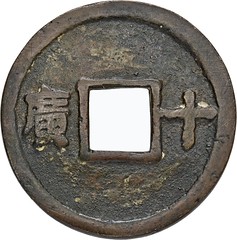
No. 5507: China. Hong Wu, 1368-1399. 10 cash, n.d. Very rare. From the collection of a sinologist from an old family estate. About very fine. Estimate: 500 euros


No. 5522: China. Qing dynasty. Qian Lon Tan Bao. Cash pattern, n.d. (ca. 1866-1870), Heaton Mint / Birmingham. Unpublished and unique. Estimate: 15,000 euros
A significant part of the collection consists of some of China's earliest minted issues, from a time when the country collaborated with European machine manufacturers in an attempt to adapt its coinage system to Western standards. Connoisseurs can look forward to extremely rare patterns that were produced, for example, through the collaboration between the Schuler machine factory in Göppingen – which still is selling coin presses to the worlds' mints today – and the Otto Beh engraving company in Esslingen. But the auction also features numerous highly interesting early issues created by the Chinese mints that soon were established across the country.


No. 5526: China. Province of Fengtien. 1 dollar, year 24 (1898). Variety with narrow-mouthed dragon and blunt "one". Rare. From the collection of a sinologist from an old family estate. PCGS Environmental Damage - XF Detail. Very fine to extremely fine. Estimate: 2,000 euros
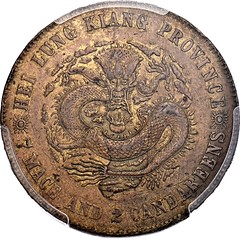

No. 5531: China. Province of Heilongjiang. 1 dollar, n.d. (1896). Brass pattern by Otto Beh (Esslingen). Extremely rare. From the collection of a sinologist from an old family estate. PCGS Rim Damage - AU Detail. Very fine to extremely fine. Estimate: 15,000 euros

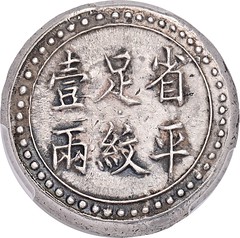
No. 5533: China. Province of Hunan. 1 tael, n.d. (1906). From the collection of a sinologist from an old family estate. PCGS Cleaned - AU Detail. Very fine to extremely fine. Estimate: 3,500 euros


No. 5536: China. Province of Hubei. Tael, year 30 (1904). Variety with small characters. From the collection of a sinologist from an old family estate. Very rare. PCGS Repaired - XF Detail. Very fine. Estimate: 5,000 euros
From a historical perspective, the most interesting period was the one that followed the end of imperial rule, when the future of China was at stake. Many forces competed for influence at the time, leaving their own issues before the communist government prevailed and largely shielded the country from outside influences.


No. 5545: China. Province of Kweichow. Auto Dollar, year 17 (1928). Variety with two blades of grass and normal doors. Rare. From the collection of a sinologist from an old family estate. Rare. PCGS Repaired - VF Detail. Very fine. Estimate: 3,500 euros


No. 5577: Republic. 1923 silver medal commemorating the inauguration of President Tsao Kun. From the collection of a sinologist from an old family estate. NGC Residue. Very fine. Estimate: 3,500 euros


No. 5582: Republic. 1 dollar, year 21 (1932). Sun Yat-Sen. Variety with geese over junk. From the collection of a Berlin numisnautist. Extremely fine. Estimate: 3,500 euros


No. 5584: Republic. 10 cents, year 25 (1936), minted in Vienna. Very rare in this quality. Proof. Estimate: 5,000 euros


No. 5586: Soviet Republic. Province of Sze-Chuen-Shensi. 1 dollar, 1934. Variety with small, filled-in stars, with "o" and with hammer handle over sickle blade. From the collection of a sinologist from an old family estate. PCGS Cleaned - XF Detail. Very fine. Estimate: 4,000 euros
In the late 1970s, China began issuing commemorative coins for the international collectors' market. From the outset, those responsible placed great importance on incorporating their own culture into the coin designs, using their coins as ambassadors for the country. This has made China's modern coins more interesting, as quite a few sets were produced in very small quantities because Western interest in these coins collapsed in the late 1980s and early 1990s. Mintage figures themselves say relatively little about the rarity of the pieces, as the announced mintage figures were often not fully utilized, or the coins were melted down at a later date.
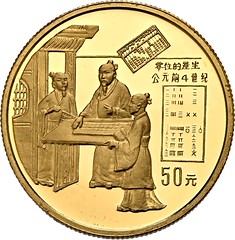

No. 5588: People's Republic. Set of 5 x 50 yuan, 1993. Inventions & Discoveries of Antiquity. Complete 2nd series. Very rare. Mintage indicated as 1,200. In original case, without original certificates. Proof. Estimate: 7,500 euros
To order a catalog contact Künker, Nobbenburger Straße 4a, 49076 Osnabrück; phone: +49 541 / 962020; fax: +49 541 / 9620222; or via e-mail: service@kuenker.de. You can access the auction catalogs online at www.kuenker.de. If you want to submit your bid from your computer at home, please remember to register for this service in good time.
STACK'S BOWERS: JOHN PACK WASHINGTONIANA
Stack's Bowers will be selling the Washingtoniana from the John M. Pack Collection on November 12. Select items are discussed below. -Garrett
Undated (ca. 1777) Voltaire Medal. Musante GW-1, Baker-78B, Betts-544. Copper. AU-58 (PCGS). 39.9 mm. 333.1 grains. For most of the history of this medallic work, it has been misunderstood because the facts surrounding its genesis were seemingly masked. As a result, collectors have been left to their own imaginative devices. Though the medal was produced by a skilled hand, neither die bears the signature of an engraver. The assignment of a French origin is easy to apply based solely on the French language reverse inscription, but to this day, the source remains uncertain. The attribution of Voltaire as having some degree of authorship in the medal is another seemingly clear conclusion, as that same French-language legend is taken directly from his 1723 poem, La Henriade. The circumstances of Voltaire's life around the time of the issuance of this medal, however, make it quite unlikely that his hand was involved. Though it has long been accepted as the first portrait medal of Washington, the conspicuous fact that the portrait looks nothing like Washington has perplexed many collectors. Indeed, the Voltaire medal is shrouded in a degree of mystery that is difficult to accept as anything other than purposeful.
Long housed in its original wooden box, the medal has been protected to a degree, but it is clear that over the centuries it has been handled, studied, shown and appreciated. There is no mistaking that. The largely deep brown surfaces are slightly worn, displaying pastel iridescence in the obverse fields while areas of the reverse have toned more deeply. Both sides are somewhat mottled, and the obverse exhibits some scattered handling marks. The box shows considerable age and handling, though it is perfectly intact. The manuscript paper label remains not only intact, but respectably legible for the 200 years of handling it has seen.
Provenance: From the John M. Pack Collection. Earlier from Benjamin Franklin; presented by Franklin to Isaac-Jean-Georges-Jonas Grand ("Georges Grand") in Paris, 1778; gifted by Grand to the father of Jos. Cook, by 1793; Jos. Cook, by descent; unknown intermediaries; John Kraljevich Americana, December 2021.
To read the complete item description, see:
Undated (ca. 1777) Voltaire Medal. Musante GW-1, Baker-78B, Betts-544. Copper. AU-58 (PCGS).
(https://auctions.stacksbowers.com/lots/view/3-1MZTVY/undated-ca-1777-voltaire-medal-musante-gw-1-baker-78b-betts-544-copper-au-58-pcgs)
"1776" (ca. 1789) Washington Before Boston Medal. First Paris Mint Issue. First Issued "Original" Obverse / First Issued "Original" Reverse. Musante GW-09-P1, Baker-47B, Adams-Bentley 3. Bronze. Plain Edge. MS-63 BN (PCGS). 68.4 mm. 2149.6 grains. An exceptionally attractive example of this classic Washington medal, struck from relatively early state dies in a handsome composition. While some of the original Washington Before Boston medals come with a dark mahogany bronzed finish, this (and some others seen) were not bronzed, that treatment likely being applied to slightly later strikes from the dies intended specifically for sale to historical medal collectors.
Since the original gold presentation medal was struck for Washington in 1789, it seems that the Washington Before Boston medal has been widely considered a prized possession. Early on, silver and bronze medals were likely distributed to participants in the Siege of Boston, their families, friends, and others who celebrated Washington's clever action atop Dorchester Heights, a pivotal and encouraging victory for the Continental Army that inspired the medal.
The Washington Before Boston has stood the test of time as a lasting memorial to Washington and his broader success in the cause of the American Revolution. The medals have been in production to some degree ever since the originals like this were struck, or at least comfortably into the 20th century, by both the Paris Mint and the United States Mint. Collections can be made of just this medal (with all the variations), but originals, as here, from the original Paris Mint dies have always been the most beloved and sought after. Not surprising, as these were from the same dies that struck Washington's gold medal and are thus the tangible objects most closely related to the entire historic affair and the people involved-George Washington being central.
From the John M. Pack Collection. Earlier from Baldwin's of St. James' Auction 37, September 2019, lot 574; Stack's Bowers Galleries, via direct sale, October 2019.
To read the complete item description, see:
"1776" (ca. 1789) Washington Before Boston Medal. First Paris Mint Issue. First Issued "Original" Obverse / First Issued "Original" Reverse. Musante GW-09-P1, Baker-47B, Adams-Bentley 3. Bronze. Plain Edge. MS-63 BN (PCGS).
(https://auctions.stacksbowers.com/lots/view/3-1MZTXJ/1776-ca-1789-washington-before-boston-medal-first-paris-mint-issue-first-issued-original-obverse-first-issued-original-reve)
"1789" (ca. 1792) Washington Born Virginia Copper. Legend Reverse. Musante GW-33, Baker-60, W-10730. Second Reverse. Copper. Plain Edge. EF-40 (PCGS). Aside from a small group of magnificent and extremely expensive Mint State pieces, most survivors are Very Fine and lower, and have such poor central detail that they are just outright undesirable examples of the type. This one is pleasant in every respect, with just a tiny rim bump noted at the lower obverse and a trivial nick at the N of BORN worthy of mention. According to direct communication with the former owner, this piece "represented the type in the family collection since probably the 1970s," until its sale in late 2023.
From the John M. Pack Collection. Earlier from our sale of the E Pluribus Unum Collection, November 2023, lot 2149.
To read the complete item description, see:
"1789" (ca. 1792) Washington Born Virginia Copper. Legend Reverse. Musante GW-33, Baker-60, W-10730. Second Reverse. Copper. Plain Edge. EF-40 (PCGS).
(https://auctions.stacksbowers.com/lots/view/3-1MZU17/1789-ca-1792-washington-born-virginia-copper-legend-reverse-musante-gw-33-baker-60-w-10730-second-reverse-copper-plain-edge)
1797 Presidency Resigned Medal. By Thomas Wyon. Musante GW-64, Baker-66. White Metal. AU-50 (PCGS). 37.6 mm. 391.9 grains. An interesting feature of this and other Wyon medals in this series (as well as the Twigg medals, GW-38), is the small irregularity struck into the center. It is occasionally on the obverse, but more frequently seen on the reverse, as here. This is the remnant of the casting sprue from when the cast planchets were produced. As such, these planchets were cast in a similar manner to how button manufacturers cast pewter buttons at the same time. This would be ideal for planchets to be struck, as a sprue on the edge would need to be filed off by the medallist, while a central sprue could be simply struck flat by the dies, reducing effort and production time.
The Wyon piece that Baker cataloged as his B-66 is actually known in four different die combinations, there being three known obverse dies and two known reverse dies. These are described by Musante as GW-63, 64, and 65, with the fourth combination noticed by the present writer, represented by four examples including the Rulau-Fuld plate medal. Considering the multiple dies, the inexpensive composition and the softness of the metal (which would not have been particularly taxing on the dies) these medals are amazingly rare. At the time of writing, there are just five known of this variety. Two are very nice, two are very problematic and this pleasing one is the lone example in the middle of these extremes. These Wyon issues are among the toughest early Washington medals to find, particularly without serious flaws.
From the John M. Pack Collection. Earlier ex John Kraljevich Americana, September 2023.
To read the complete item description, see:
1797 Presidency Resigned Medal. By Thomas Wyon. Musante GW-64, Baker-66. White Metal. AU-50 (PCGS).
(https://auctions.stacksbowers.com/lots/view/3-1MZU6B/1797-presidency-resigned-medal-by-thomas-wyon-musante-gw-64-baker-66-white-metal-au-50-pcgs)
1798 Washington Seasons Medal. The Home. Intermediate Reverse Die State. Musante GW-69, Baker-172A, Julian IP-52. Copper. Specimen-40 (PCGS). 48.2 mm. 722.7 grains. Though the Seasons medals do not bear a portrait of Washington, they are inextricably tied to him, his administration and his memory. The direct inspiration for the designs of these medals was from George Washington's own pen. On August 29, 1796, George Washington wrote a letter to the Cherokee Nation, the complete text of which is easily found on the website of the National Archives. The letter was meant to address relations with the Cherokee by way of instruction as to how they might improve their standing as peaceful neighbors of the white settlers. It is a fascinating read for its insights into Washington's thoughtful manner, but also into the decidedly inconsiderate and absolute approach the administration took toward Native peoples. Washington was specific and presented his own personal desires to retire to his plantation as guidance for how the Cherokee might best live in peace and prosperity. He described the advantages of expanding livestock and crops and that "your wives and daughters can soon learn to spin and to weave," relating directly to the presently offered medal.
Your cataloger's years-long study of the Indian Peace medals has recorded 17 known examples of this medal in bronze. At least three were collector's strikes, and three more are in the museum holdings of the American Numismatic Society, Massachusetts Historical Society and Yale University Art Gallery. Again, among the 17, this is the only one known with its suspension loop intact. Acquired from a non-numismatic eBay seller in Virginia, and thus a relatively recent discovery. Offered here to a dedicated numismatic audience for the first time.
From the John M. Pack Collection. Earlier via eBay, January 2019.
To read the complete item description, see:
1798 Washington Seasons Medal. The Home. Intermediate Reverse Die State. Musante GW-69, Baker-172A, Julian IP-52. Copper. Specimen-40 (PCGS).
(https://auctions.stacksbowers.com/lots/view/3-1MZU6V/1798-washington-seasons-medal-the-home-intermediate-reverse-die-state-musante-gw-69-baker-172a-julian-ip-52-copper-specimen-40-p)
"1799" (ca. 1800) Washington Funeral Urn Medal. Musante GW-70, Baker-166A, Fuld Dies 1-B. Silver. AU-58 (PCGS). The short window of time between Washington's passing, on December 14 and the first of the numerous funeral processions introduces a degree of wonderment that Perkins could accomplish so much engraving and striking of what appears to be a considerable number of these medals in time for the targeted events. While Washington died on the 14th, news of the day did not travel quickly, and yet, Perkins was advertising the medals for sale as early as January 3. With at least 14 dies having been individually hand-made, he must have devoted every waking hour to these issues from the time he learned the news to the time of sale. Unlike many Washington portrait medals, these were purpose driven, made specifically for display during Washington's funeral processions. As such, they are far more historic and significant than many of the other early Washington medals.
From the John M. Pack Collection. Earlier ex F.C.C. Boyd estate; our (Stack's) sale of the John J. Ford, Jr. Collection, Part II, May 2004, lot 172; Lawrence R. Stack Collection, November 2006; our sale of the Sydney F. Martin Collection, November 2022, lot 2083.
To read the complete item description, see:
"1799" (ca. 1800) Washington Funeral Urn Medal. Musante GW-70, Baker-166A, Fuld Dies 1-B. Silver. AU-58 (PCGS).
(https://auctions.stacksbowers.com/lots/view/3-1MZU76/1799-ca-1800-washington-funeral-urn-medal-musante-gw-70-baker-166a-fuld-dies-1-b-silver-au-58-pcgs)
1800 Hero of Freedom Medal. Musante GW-81, Baker-79C. Bronze, Fire Gilt. MS-63 (PCGS). This was likely also struck over a cut down 1797 British penny. This has long been a favorite among the medals in this collection.
From the John M. Pack Collection. Earlier ex Fred Baldwin; a "collection from the 1950s;" John Kraljevich Americana, December 2013.
To read the complete item description, see:
1800 Hero of Freedom Medal. Musante GW-81, Baker-79C. Bronze, Fire Gilt. MS-63 (PCGS).
(https://auctions.stacksbowers.com/lots/view/3-1MZUB5/1800-hero-of-freedom-medal-musante-gw-81-baker-79c-bronze-fire-gilt-ms-63-pcgs)
1803 Washington Fame Medal. Musante GW-87, Baker-84. Copper, Bronzed. Specimen-63 (PCGS). The Fame medal is widely considered to be the most beautifully styled of the early memorial medals. Since the early days of American numismatics, it has been prized. In the 1862 David McGilvray sale of coin dealer Henry Cook's property, a Fame medal was described as "the first offered at public sale in this country" and realized $37.50. The following year, and with the medal apparently newly known to American collectors, William Sumner Appleton paid $125 for his in Woodward's October 1863 sale. In 1864, the John McCoy specimen sold to J.N.T. Levick for $85, all substantial sums during the American Civil War. In 1882, one was given valuable space on the Bushnell catalog plate.
The Fame medal was among the classic Washington pieces produced in England for sale into both European and American cabinets. Though long mis-attributed as to maker, this medal is clearly the work of John Gregory Hancock based on stylistic comparison. Other medals by Hancock produced in this era that share this style include such pieces as the Robert Banks Secretary of State medal of 1803 (BHM-548) and the 1806 Death of William Pitt medal (BHM-613).
In addition to the notable provenance given below, extending back comfortably more than a century, this was plated in George Fuld's article, "Early Washington Medals" in the American Journal of Numismatics, Second Series #14, 2002, pg.139. This is one of just 23 examples recorded by the writer.
From the John M. Pack Collection. Earlier ex S.H. Chapman's sale of the Henry L. Jewett Collection; June 1909, lot 425, at $5, to "C" which is "Chapman"; our (Bowers & Ruddy's) sale of the Stanley Scott Collection, June 1975, lot 470; unknown party to Jack Collins, privately, November 1988; our (Stack's) sale of the Jack Collins Sale, Part I, April-May 1996, lot 90; our sale of the Charles Wharton Collection, March 2014, lot 2108.
To read the complete item description, see:
1803 Washington Fame Medal. Musante GW-87, Baker-84. Copper, Bronzed. Specimen-63 (PCGS).
(https://auctions.stacksbowers.com/lots/view/3-1MZUGI/1803-washington-fame-medal-musante-gw-87-baker-84-copper-bronzed-specimen-63-pcgs)
1805 Eccleston Medal. Musante GW-88, Baker-85. Bronze. Specimen-64 RB (PCGS). The Eccleston medal is a classic early Washington piece and is beloved for its considerable size, elegant styling and still somewhat unexplained reverse design featuring a Native American and the legend, THIS LAND WAS OURS. The message here, coupled with the sentiments toward Washington, has been a matter of debate as to intent for a long time. Though it is frequently analyzed as sympathetic to the cause of the Native peoples who were becoming increasingly displaced, one must take care to not make judgements on early 19th-century motifs through the lens of the present. The general is cuirassed in grand form on the obverse, the unmistakable image of a victor. When coupled with the sentiment of the central reverse, it is worth acknowledging that Washington himself wrote to the Cherokee to recommend that they essentially learn to live as whites did, for their own prosperity. In 1805, the institution of slavery was legal in the United States and Great Britain, and the British Empire would continue to exploit as many territories and indigenous peoples as possible around the world for decades to come. Native American policy in the United States was no better. This said, the thoughts of any individual might differ vastly from societal norms en vogue at any given time, and the fact that the Native American would be acknowledged at all is probably highly significant. Unfortunately, Eccleston gave no clues in his own presentation letter that he sent to Thomas Jefferson with examples of the medal. In it he simply referred to the entire reverse as bearing "an American Indian with his bow and arrow, and an appropriate legend."
This was amazingly one of nine Eccleston medals revealed in Part II of our sale of the John J. Ford, Jr. holdings-obviously a Ford favorite. It was the second Eccleston offered therein and the singular one chosen for the sale's color plates, in two different places, one being a full page devoted to it. Michael Hodder, in writing that sale, noted it to be "absolutely spectacular" and "the only one this cataloguer has ever seen with this degree of mint red remaining…the mint color lending a remarkable three-dimensionality to the piece." Two people have informed the writer that this is the only Ford sale lot the late esteemed dealer and large-cent collector Doug Bird bought, a notable fact.
From the John M. Pack Collection. Earlier ex Fred Baldwin, June 1967; our (Stack's) sale of the John J. Ford, Jr. Collection, Part II, May 2004, lot 138; Doug Bird (said to be the only lot he bought from Ford); John Kraljevich Americana, November 2019, at the Baltimore Show.
To read the complete item description, see:
1805 Eccleston Medal. Musante GW-88, Baker-85. Bronze. Specimen-64 RB (PCGS).
(https://auctions.stacksbowers.com/lots/view/3-1MZUIO/1805-eccleston-medal-musante-gw-88-baker-85-bronze-specimen-64-rb-pcgs)
1808 Washington Benevolent Society Medal, Sash and Silk. Musante GW-94, Baker-327, Julian RF-23. Silver. Virtually Mint State. Contemporary newspaper reports on the public activities of the Benevolent Society occasionally specify that badges were to be worn through the upper left breast buttonhole. Presumably, the badges referenced were the silver medals of this type, engraved by Reich and struck at the U.S. Mint, as other contenders such as the silk ribbons that could have been referred to as "badges" would not make sense for such a point of fixture.
This piece was clearly not worn in such a fashion, however. The mode of display was much more elegant and would have given much greater prominence to the person wearing this adornment. Most likely, a display of this manner would have been reserved for members of the society of some significant rank, or it would have been reserved for those serving as marshals leading processions of society members at public events. The society did parade at special occasions, often marking the birthday of Washington on February 22.
Most of the Benevolent Society medals encountered are simply the round disc, often with the original suspension hanger lost. The intact hangers do not appear fragile, but some of these medals do seem to be somewhat hard worn. Occasionally a nice one is seen with a hanger, but evidence of some use is almost always visible. The writer has seen one very nice example with a plain black ribbon of some age, for suspension around the neck, but that was a single sighting.
From the John M. Pack Collection. Earlier ex the J. Doyle DeWitt Collection; Heritage, by direct purchase; Heritage, October 2022, lot 43660, via John Kraljevich Americana.
To read the complete item description, see:
1808 Washington Benevolent Society Medal, Sash and Silk. Musante GW-94, Baker-327, Julian RF-23. Silver. Virtually Mint State.
(https://auctions.stacksbowers.com/lots/view/3-1MZUN5/1808-washington-benevolent-society-medal-sash-and-silk-musante-gw-94-baker-327-julian-rf-23-silver-virtually-mint-state)
1824 Lafayette Visit Medalet. Likely by Charles James Joullain. Musante GW-112, Baker-198A. Silver. AU-50 (PCGS). Approximately 14.5 mm, without the loop. The vintage and purpose of these medals are undisputed. They were struck to mark the occasion of the Marquis de Lafayette's return to the United States for an American tour in 1824. He arrived on August 15 and across the next 14 months, he visited each State of the Union enjoying celebrity status and reverence at every turn. A wide array of objects was sold to mark his return tour, including medals, thematic gloves, badges, belts, combs, chains, socks, silks and other goods. Formal engagements included visits to Mount Vernon, a Congressional Banquet, a reception at the White House and others. A Grand Fete at New York's Castle Garden was advertised for September 10, and a "Grand Jubilee" in Philadelphia for October 4. Though a French National, his celebrity in the United States was substantial in an era when elder Americans could recall the days of the Revolution. Probably only the memories of Washington and Franklin were dearer to average citizens.
The matter of who made these medals has long presented quite the opposite situation. Since the time of the Civil War, these medals have mostly been attributed to Charles Cushing Wright, a resident of New York in 1824, and business partner (circa 1823-1827) of Asher B. Durand. Durand was a prominent copper and steel plate engraver and, later, painter of the Hudson River School. Wright was a highly skilled medallic engraver, though not known to have been prolific at this early year in his career. Both men were central figures in the establishment of the National Academy of Design a few years later. Durand and Wright engraved and printed the admission tickets to the Castle Garden Grand Fete. Advertising of James D. Stout of New York on September 9, 1824, offered commemorative gloves bearing an engraved portrait of Lafayette by C.C. Wright.
From the John M. Pack Collection. Earlier ex Henry Chapman's sale of the Captain Andrew Zabriskie Collection, June 1909, lot 122, at $4, plated, with jump ring, since removed; The United States Coin Company's (Wayte Raymond) sale of the Judson Brenner Collection, June 1916, lot 57, at $3; unknown intermediaries; John Kraljevich Americana, privately, February 2013.
To read the complete item description, see:
1824 Lafayette Visit Medalet. Likely by Charles James Joullain. Musante GW-112, Baker-198A. Silver. AU-50 (PCGS).
(https://auctions.stacksbowers.com/lots/view/3-1MZUVQ/1824-lafayette-visit-medalet-likely-by-charles-james-joullain-musante-gw-112-baker-198a-silver-au-50-pcgs)
1856 Buchanan & Breckinridge Campaign Medal. The "Buck-Cannon" Rebus Medal. Musante GW-155, Baker-380A, DeWitt-JB 1856-2. White Metal. MS-65 (NGC). 46.2 mm. Our online archives include just four examples of this medal in this composition. The date of issue and reverse design tie this medal to the Presidential campaign of James Buchanan and his running mate John C. Breckenridge through a cleverly designed and memorable rebus representing Buchanan through the depiction of a buck and a cannon in a field of 32 stars. Musante points out regarding these stars that they "probably showed the candidate's support for admitting Minnesota to the union as the thirty-second state." Minnesota became the 32nd state during their administration, in 1858.
From the John M. Pack Collection. Earlier from our sale of the John J. Ford Collection, Part XXIII, August 2013, lot 21316.
To read the complete item description, see:
1856 Buchanan & Breckinridge Campaign Medal. The "Buck-Cannon" Rebus Medal. Musante GW-155, Baker-380A, DeWitt-JB 1856-2. White Metal. MS-65 (NGC).
(https://auctions.stacksbowers.com/lots/view/3-1MZV5C/1856-buchanan-breckinridge-campaign-medal-the-buck-cannon-rebus-medal-musante-gw-155-baker-380a-dewitt-jb-1856-2-white-metal-m)
1862 District of Columbia Emancipation Badge. GRATE JOY TO OUR RACE. Musante GW-566, Baker-620B, Meier-Stahl 3C. Brass, Gilt. MS-61 (PCGS). 31.0 mm. It is widely known that Abraham Lincoln signed the nation-wide Emancipation Proclamation on January 1, 1863. It is also widely recognized that Emancipation was finally ordered in Texas on June 19, 1865-an action celebrated as the end of slavery in the United States and acknowledged by a federal holiday to this day in Juneteenth National Independence Day. What is not widely known is that Emancipation came first to the city of Washington, D.C., on April 16, 1862, through The D.C. Compensated Emancipation Act. It seems that the District of Columbia was singled out after successful abolitionist efforts by Massachusetts Senator Charles Sumner to alert Lincoln that he, as the Chief Executive of the federally administered District of Columbia, held the power to unilaterally free all the enslaved persons in the District. The effective argument had been made that having that opportunity but not taking advantage of it was tantamount to being the slaveholder directly-and the largest in the nation. There were 3,100 enslaved persons in Washington freed by the action and, naturally, there was great enthusiasm and encouragement felt among local African Americans as well as the broader abolitionist community, well beyond the confines of the District of Columbia.
The more specific history of these remains uncertain, as we have only the few badges themselves and the names known to have been punched into some of them as evidence to work from. While it has long been believed that these are the names of former slaves and that these were made in celebration immediately upon the signing of the Act in 1862, it is the opinion of the writer that a more likely scenario is that all of these badges were produced and sold at an event such as the 1866 Emancipation Parade referenced above. They would be no less significant as such. The Grate Joy type was likely prepared in advance for sale, while the named medals were probably punched to order on site-just as the soldier's identification badges had been during the war. Being personalized, they were likely more widely desired and sold in somewhat greater number.
From the John M. Pack Collection. Earlier from an unidentified New England Family, via eBay, June 2018.
To read the complete item description, see:
1862 District of Columbia Emancipation Badge. GRATE JOY TO OUR RACE. Musante GW-566, Baker-620B, Meier-Stahl 3C. Brass, Gilt. MS-61 (PCGS).
(https://auctions.stacksbowers.com/lots/view/3-1MZW1P/1862-district-of-columbia-emancipation-badge-grate-joy-to-our-race-musante-gw-566-baker-620b-meier-stahl-3c-brass-gilt-ms-61-pcgs)
HERITAGE: NOV. 13-14 U.S. COINS SIGNATURE
Heritage published the following article in their latest press release entitled Condition Census 1908-S Double Eagle Takes Flight at Heritage's U.S. Coins Auction. -Garrett
One of the highest-graded examples from the lowest mintage Saint-Gaudens With Motto issue will be thrust into the spotlight when it crosses the auction block in Heritage's Nov. 13-14 U.S. Coins Signature® Auction — an event that includes an exceptional selection of rare and high-end gold.
The 1908-S Double Eagle, MS67 PCGS. CAC from The Alymaya Collection, Part III that is in play in this auction is an extraordinary numismatic prize: PCGS has awarded higher grades to just two others.
"This is a spectacular coin, and one that immediately will be a strong addition to any collection," says Todd Imhof, Executive Vice President at Heritage Auctions. "Any coin from such a small mintage is exceedingly scarce, and to find one in this condition represents an extremely rare opportunity."
The first two parts of the Alymaya Collection were featured in Heritage's Oct. 2-5 GACC U.S. Coins Signature® Auction and the Aug. 26-31 ANA U.S. Coins Signature® Auction.
Most 1908-S double eagles are known in circulated grades, which is unusual among Saint-Gaudens issues, in part because of the long-standing "hard money" tradition of the Old West, where gold was the preferred medium of exchange — a trend that remained true even once the gold and silver parity was reestablished in 1878 after decades of imbalance.
Another standout in the auction is a 1907 Wire Rim Indian Eagle With Irregular Edge Stars, MS64 PCGS — a sought-after key rarity with only four examples certified. Traditionally, all Wire Rim Indian eagles have been listed in the leading pattern reference as Judd-1901, but recent research by Roger W. Burdette has established that most should more properly be considered circulation-strike coins, not experimental issues. Nonetheless, a handful of true patterns are known and can be identified by the Irregular Edge Stars collar used to strike them. This is the first of these remarkable experimental pieces Heritage has handled.
A 1795 BD-1 Eagle, MS61 NGC is a beautiful example of the popular "13 Leaves" variety that is one of the most highly sought type coins in the U.S. gold series. As the largest gold coin in the realm, the early ten dollar gold pieces were intended to compete with the circulating Spanish eight escudo pieces, although in 1795, the half eagle was preferred in both domestic and international trade. Of those from all of the "13 Leaves" varieties graded by NGC, this is one of just eight graded MS61, and there are only nine carrying higher grades.
An 1879 Flowing Hair Stella, PR66 Cameo NGC is a magnificent, fresh-to-market example of this extremely popular coin — one of just 20 to earn a 66 Cameo grade, with only 10 receiving higher grades. Stellas came about as a result of Philadelphia patent lawyer and inventor Dr. William Wheeler Hubbell's efforts to create an international trade coinage based on the metric system and struck in his patented goloid alloy. Patterns were struck in various metals, using two different obverse designs bearing two different dates — of which gold pieces dated 1879 with the Flowing Hair design were the coins struck and distributed to Congressmen.
Listed in 100 Greatest U.S. Coins, an 1861-S Paquet Reverse Twenty, AU55 PCGS is an exceptional example of the rarest of all San Francisco double eagles, with only about 200 pieces extant. With a reverse that was modified in 1861 by Mint Assistant Engraver Anthony C. Paquet, it slipped quietly into commercial channels, many to settle large accounts in foreign trade. The small mintage circulated for years but some were lost to attrition. In 1937, when collecting large denomination gold coins had attained a measure of popularity, an S-Mint Paquet twenty was discovered under an old barn in Hull, Texas, with some other gold coins. More examples eventually turned up, primarily examples repatriated from European holdings in recent years, but the issue remains elusive in all grades. Until recently, no Mint State examples were known, but a single MS61 example and an MS62 specimen now show on the PCGS Population Report, and the NGC Census lists a single MS61 coin.
A "Two-Tailed" Washington Quarter Mule, MS64 — an undated Washington quarter mule that was struck with two reverse dies — is a magnificent example of the mule many collectors consider to be the Holy Grail among U.S. coin errors. This example is one of only a few dozen known across all types, series and denominations. The rarest mules are those "double sided" coins — like this one — that were struck with two obverse or two reverse dies. The coin offered in this auction is a new discovery of this magnificent mule, acquired years ago by the consignor as part of an estate sale purchase.
An 1861-D Half Eagle AU55 PCGS. Winter 47-GG is considered, along with the equally famous 1861-D gold dollar, the great prize among all Dahlonega gold issues. By act of Congress, the Dahlonega Mint was allowed to coin silver denominations, but there was no ready supply of silver bullion and the coining presses were not large enough to strike quarters, half dollars or silver dollars. That left only gold dollars, quarter eagles and half eagles as the sole output from the Georgia facility. Just 1,597 were struck during the first few months of the year when the Mint was under Federal control, followed by an unknown but small number of five dollar gold pieces struck under Confederate authority.
A 1895 Morgan Dollar PR65 Cameo NGC. VAM-2 is from an original proof mintage of just 880 pieces, a total that falls far short of collector demand. Mint records indicated a circulation strike of 12,000, coins that Roger Burdette concluded never were paid out. Instead, the entire issue was melted under terms of the 1918 Pittman Act, when about 350 million silver dollars were converted into bullion.
The second-finest 1865 Liberty Half Eagle, PR64 Cameo PCGS. CAC is one of just 25 struck that year, as the Civil War dragged to a close. PCGS has 12 certification events for the 1865 proof Liberty half eagle in its Population Report, while NGC has recorded 14 submissions in its Census — totals that include an unknown number of resubmissions and crossovers. PCGS CoinFacts suggests 15-20 examples of this issue are extant, while John Dannreuther suggests in his series reference, United States Proof Coins, Volume IV: Gold, a surviving population of just 12-14 examples in all grades. It is the only example graded in 64 Cameo, with one finer.
From The Texas Republic Ranch Collection comes an 1800 Capped Bust Right Half Eagle, MS64 PCGS. CAC. According to the 2026 Guide Book, the Philadelphia Mint struck a substantial mintage of 37,628 Capped Bust Right half eagles in 1800, but die evidence indicates some likely were dated 1799. The offered coin is a representative of the BD-4 variety, and Dannreuther estimates that 5,000-7,500 were produced with the BD-4 dies. The surviving population is estimated at 125-175 examples in all grades. Just 10 are graded 64, with just one 64+ and only one graded finer.
Images and information about all lots in the auction can be found at HA.com/1387.
THE RESTORATION COINAGE OF TRAJAN DECIUS
Mike Markowitz wrote an article in CoinWeek on The Restoration Coinage of Trajan Decius. -Garrett
As part of his effort to promote traditional beliefs, Trajan Decius issued a series of coins commemorating eleven of his deified predecessors. Numismatists refer to these coins as the Divi series, or the "Consecration" or "Restoration" coinage of Trajan Decius.
Some deified former emperors were not included and numismatists are baffled by who made the list and who did not. There were no coins for Julius Caesar, Claudius, Lucius Verus, Pertinax or Caracalla, who were all deified.
The coins were antoniniani, or "double denarii" of debased silver. Carelessly struck, often from worn dies on ragged blanks, these pieces generally bear portraits of excellent quality, suggesting that the engravers were familiar with coins that were as much as two centuries old at the time. Each emperor depicted wears the spiked "radiate crown" that was the symbol for the double denarius denomination, although it is very unlikely that any of these men would have ever actually worn such headgear.
There were two different reverses: one type shows a square altar topped by a flame, the other shows an eagle, companion of the god Jupiter, that was believed to carry the souls of the deified to Olympus to dwell among the gods.
Minor differences in the obverse inscriptions make the complete set total about thirty different types. The usual obverse inscription is in the "dative case" – the Latin grammatical form that hails the subject — "to the Divine So-and-so." The reverse inscription is CONSECRATIO, the Latin term for making something or someone sacred.
The portrait of Augustus on this type is unusually mature. Most of the coin portraits from the long reign of Augustus Caesar (27 BCE to 14 CE) show him as a youthful twenty-something, although he lived to the advanced age of 75.
A tough military man with a wry sense of humor, Vespasian ruled from 69 to 79 CE after crushing the revolt of the Jews, and defeating a series of rivals in the "Year of Four Emperors". Vespasian's ironic last words to his attendants before he died were "Woe is me. I think I'm turning into a god" (Vae, puto deus fio).
To read the complete article, see:
The Restoration Coinage Of Trajan Decius
(https://coinweek.com/not-forgotten-the-restoration-coinage-of-trajan-decius/)
1715 FLEET: A 1703 LIMA MINT EIGHT REALES
The 1715 Fleet Society is a non-profit organization that is "dedicated to researching the history of the 1715 Fleet, its loss, rediscovery, and recovery." The 1715 fleet was part of the Spanish New World Treasure Fleets that funded Spain's activities as a world leader.
Each month the group highlights a "Treasure of the Month". November's treasure is a 1703 Lima Mint Eight Reales from the maor find reported last month. -Editor
Our Treasure of the Month for November is a tiny piece of last month's Treasure of the Month. In October, we featured a recent find of over 1,000 silver eight reales coins recovered in July 2025 by Captain Levin Shavers and the crew of the M/V Just Right. Our treasure is a beautiful eight reales from the Spanish colonial mint located in Lima, Peru.
The obverse of this coin reveals an almost perfectly centered feature with a bold "703" designating the year the coin was minted — 1703. Likewise, the reverse displays a perfectly centered cross with visible lions and castles.
The assayer "H" (for José Hurtado) is located on the obverse at the 7:00 o'clock position and on the reverse at the 3:00 o'clock position. Hurtado was the assayer at the Lima mint from 1696 to 1711 and accounts for many of the Lima silver coins found on the Fleet. Lima eight reales coins are relatively round and well struck, as exemplified by our featured treasure. When compared to other colonial mints such as Potosi, it is apparent that the mint workers in the Lima mint were better artisans.
Notably, our Treasure of the Month was only recently recovered from its watery grave after being submerged for 310 years. This submersion did have an effect, as can be seen below. Before conservation, our coin was covered with more than three centuries of corrosion and ocean deposits. After conservation, it looks very much like the day it was minted. What corrosion there was did not have a great impact on the coin as it still retained much of its original weight.
As previously indicated, coins from the Lima mint were well struck and characterized by excellent die engraving. Several examples (below) from the 1715 Fleet Society's Research Collection attest to this fact.
Special thanks to Sal Guttuso, Operations Manager of 1715 Fleet — Queens Jewels, LLC, and Mike Perna, Captain of the Mighty Mo, for providing images used in this post.
To read the complete article, see:
November 2025 — Treasure of the Month
(https://1715fleetsociety.com/november-2025-treasure-of-the-month/)
For more information on the 1715 Fleet Society, see:
https://1715fleetsociety.com/
To read the earlier E-Sylum article, see:
1715 FLEET: 1,000 COIN TREASURE CHEST FIND
(https://www.coinbooks.org/v28/esylum_v28n40a16.html)
ON ARCHAEOLOGISTS AND TREASURE HUNTERS
A Washington Post Opinion piece by the author of the upcoming book Neptune's Fortune discusses the "uneasy symbiosis" of archaeologists and treasure hunters. See also the previous article in this issue from the 1715 Fleet Society and the one elsewhere in this issue on the book. -Editor
 Julian Sancton is the author of the forthcoming book "Neptune's Fortune: The Billion-Dollar Shipwreck and the Ghosts of the Spanish Empire."
Julian Sancton is the author of the forthcoming book "Neptune's Fortune: The Billion-Dollar Shipwreck and the Ghosts of the Spanish Empire."
On the night of July 30, 1715, a dozen Spanish ships were sailing north along Florida's Atlantic coast, weighed down with gold and silver stripped from the mines of the New World. Before dawn, a hurricane swept across the fleet's path. It resulted in one of the deadliest maritime disasters in history, sinking 11 ships, killing more than 1,000 men and sending tons of gold and silver coins down to the ocean floor — worth an estimated $400 million today.
On Sept. 30, a team working for the Florida-based treasure- hunting company 1715 Fleet Queens Jewels, which has the exclusive rights to salvage the area and has been scouring it for decades, announced that it had recovered more than 1,000 tarnished silver coins from the fleet's wreckage, as well several gold escudos that gleamed as brightly as they day they were minted. It was the company's largest haul in years. Queens Jewels estimated its value at around $1 million. The coins will be catalogued before being dispersed, with many probably being sold into private collections.
Should such a treasure be for sale? Florida says yes, allowing treasure hunters to profit from the spoils of history as long as they give the state 20 percent of the booty and adhere to its relatively loose archaeological guidelines. Most archaeologists, however, say no. As even the notoriously unscrupulous Indiana Jones would say, "It belongs in a museum." Allowing the commercialization of historical artifacts, they argue, robs scholars of the chance to study them and the rest of us of the chance to see them — and encourages looting.
Yet archaeologists and treasure hunters exist in an uneasy symbiosis. The latter depend on the former to establish the context and provenance that makes findings valuable to collectors. Archaeologists, meanwhile, often lack the funding to explore shipwrecks themselves. If it weren't for the adventurism of treasure hunters, many of the most important wrecks of the Caribbean would not have been found.
Though their targets are often silver and gold, maritime treasure hunters are not primarily motivated by profit. Indeed, the pursuit of shipwrecked riches is so difficult, time consuming and legally tortuous that it is almost never profitable. They are driven largely by the romantic urge that Mark Twain identified in young Tom Sawyer: "There comes a time in every rightly constructed boy's life when he has a raging desire to go somewhere and dig for hidden treasure."
In 2001, in an effort to keep wreck plunderers at bay, UNESCO released its Convention on the Protection of Underwater Cultural Heritage. The document stipulates that the wrecks of war vessels (such as Spain's armed treasure ships) remain the property of the countries whose flag they flew, no matter how many centuries have passed since their sinking, and that their contents are ideally left untouched. Spain, unsurprisingly, ratified the convention. Among those countries that did not are two whose territorial waters are known to contain untold amounts of lost Spanish treasure: the United States and Colombia.
It was off Colombia's coast that the legendary Spanish galleon San José was discovered at a depth of 600 meters in 2015. Long described as the holy grail of shipwrecks, the San Jose and its vast treasure were sunk in a battle with the English on June 8, 1708. Estimates of its cargo's value have ranged as high as several billion dollars.
Dwarfing the value of the 1715 fleet's trove, the San José's wreckage set off a still-unresolved fight over ownership and the proper stewardship of history. Images of the sunken San José— reduced after three centuries to a flattened field of cannon and other artifacts — show gold coins glinting on the seabed, hinting at the riches that lie buried below. Yet they also show ceramic olive jars, Chinese porcelain cups, Spanish gin bottles, French medical instruments and other testaments to a rapidly globalizing world: a metaphorical gold mine for archaeologists.
Sancton advocates for serious consideration of a plan that could reimburse and satisfy the multiple parties, balancing the interests of archaeologists, investors and treasure hunters. -Editor
To read the complete article, see:
Billions in treasure lie on the seafloor. Finders keepers?
(https://www.washingtonpost.com/opinions/2025/10/30/treasure-hunter-shipwreck-treasure-san-jose/)
To read earlier E-Sylum articles, see:
SPANISH GALLEON SAN JOSE FOUND
(https://www.coinbooks.org/v21/esylum_v21n22a38.html)
THE LEGENDARY SAN JOSE WRECK
(https://www.coinbooks.org/v27/esylum_v27n28a23.html)
BARCLAY'S BANK CARIBBEAN BANKNOTES
Stack's Bowers Director of Consignments & Senior Numismatist Dennis Hengeveld published a nice article about the Caribbean Barclay's Bank specimen notes printed by Bradbury, Wilkinson & Co. -Editor
As we approach the final months of 2025 here at Stack's Bowers Galleries, we are already looking ahead to 2026. As is our tradition, the NYINC auction will be our first major world paper money event of the year. We have already started preliminary work for that sale, and I came across a group of specimen notes from the Jerry & Diane Fishman Collection that are the topic of this blog post. These specimens were printed by Bradbury, Wilkinson & Co. for Barclays Bank (Dominion, Colonial and Overseas) starting in 1926. The notes, which have always interested me, were prepared for the various branches of the bank in the Caribbean, and are a fascinating (but understudied) area of world paper money.
While the firm of Barclays can trace its history to late 17th-century London, the iteration of the company that concerns this blog post came about in 1925 following the amalgamation of the Colonial Bank, the National Bank of South Africa and the Anglo-Egyptian Bank, allowing Barclays to expand its overseas operations using the name Barclays Bank D.C.O. With the British Empire stretching across the world, the concept was the brainchild of chairman F.C. Goodenough, who wished to ease transactions of Barclays customers in the United Kingdom with the territories and thus make it easier for people to use the bank's services no matter where they were.
Today, a concept such as what Goodenough proposed might not seem out of the ordinary, but we should remember that in 1925, international travel and trade were more limited. There were certain hurdles that made having a single banking institution in many places around the world advantageous. Still, the world is a big place, so Barclays D.C.O. focused its activities in British colonies in the Caribbean and in Africa. In several of these places, the bank issued paper money, including in Rhodesia, Southwest Africa, and around the Caribbean. Elsewhere, in the Middle East and Asia, branches were opened, but the bank's activities were much more limited.
The notes in the Fishman Collection are from the Caribbean. In Antigua, Barbados, British Guiana, Grenada, Jamaica, St. Kitts, St. Lucia, St. Vincent, and Trinidad & Tobago notes were introduced in 1926 of identical designs, but identified by a different code letter and place of issue. What makes these notes so interesting is a fairly simplistic issuance system that has never been fully explored but which can be studied using specimens of this series, which typically show a printing range. Prefixes changed every 10,000 notes, and specimens were created for each print run, which could be more or fewer than 10,000 notes and appeared to have been dependent on orders of notes by the bank.
What this means is that the emission sequence of these notes can be used to determine exactly how many of each date and denomination were issued for each colony. I have worked on putting the emission sequence together for several years, and while it is not yet complete, some interesting facts can be discerned from these scarce specimens. Iit appears that for most print runs just one or two archival specimens were created, so while it might appear that most are relatively common, they are all different varieties.):
- Jamaica is the only colony that has a separate emission sequence.
- A total of 475,000 notes of the $5 denomination were printed for the other colonies in 1926, 19,500 notes were printed for the $20, and just 6,500 notes were printed for the $100 (these were the only three denominations issued).
- After 1926, most print orders each year are for one or two branches only, and for the $20 and $100, it would take until the early 1930s before additional notes were ordered by the bank for any of its branches.
- Demand varies widely by colony. The $5 denomination was printed for all branches, but the $20 and $100 were printed for select branches only, in much smaller quantities.
Looking at the print quantities, as indicated by the serial number ranges seen on these specimen notes, it is no surprise that these notes in issued format are incredibly scarce. But what few people know is that print totals are truly minuscule. For example, based on the specimens seen, just 200 notes of the $100 denomination were printed in 1931, and only for Barbados. Good luck finding an issued example, and with just one or two specimens produced, it is one of the great rarities in the commonwealth. Yet, these specimens are often quite affordable, as most people assume they are readily available, with printings in 1926, 1931, 1932, 1933, and 1935. In reality, however, locating any of the specific dates or colonies, even in specimen format, is deceptively difficult.
This is just a brief introduction to these fascinating issues. So far, no numismatic researcher appears to have taken on the challenge of fully untangling the emission sequence of this bank and its predecessor, the Colonial Bank, in the Caribbean. There are, however, several published histories of the institution itself that are well worth consulting for those interested in the broader story of Barclays Bank DCO. The most accessible of these is The DCO Story: A History of Banking in Many Countries 1925–71 by Sir Julian Crossley and John Blandford, published by the bank in London in 1975.
To read the complete article, see:
Underappreciated Rarities: Barclays Bank, D.C.O. Specimens from the Caribbean
(https://stacksbowers.com/underappreciated-rarities-barclays-bank-d-c-o-specimens-from-the-caribbean/)
AMERICAN MINT SETTLES PENNSYLVANIA LAWSUIT
A collectibles marketing business headquartered near Harrisburg, PA settled a lawsuit over its sales practices. Here's an excerpt from an article published yesterday in the Pittsburgh Post-Gazette. -Editor
A Mechanicsburg company that sells collectible coins agreed to pay $750,000 to settle an investigation by the Attorney General's Office that found the company misled customers into unwanted subscription plans through deceptive sales practices.
The settlement by America Mint, LLC, comes after more than 200 consumer complaints about the company's "negative option" subscriptions and other business practices, according to the attorney general's office.
Negative option subscriptions are where a customer's silence or inaction is interpreted as acceptance of additional purchases.
The office said they found American Mint misled customers into believing they were making one-time purchases, when they were being automatically enrolled in subscriptions that came with recurring shipments and additional charges.
Consumers were often unaware of the subscriptions and given only short time frames to return items to avoid charges tied to the subscription plan.
Under the settlement, American Mint will pay $750,000 to harmed customers, end subscription plans and stop collections efforts against more than 180,000 customers who were referred to debt collection agencies, according to a press release. The company will also revise its business and advertising practices, Attorney General Dave Sunday said.
He said the company will no longer automatically enroll customers in subscription plans without their explicit consent. All outstanding consumer debt that was sent to collections will be discharged and consumers' accounts will be cleared of outstanding charges.
The lawsuit claimed American Mint violated the Pennsylvania Unfair Trade Practices and Consumer Protection Law by using a "bait and hook" strategy that lured customers into believing that they were receiving collectibles for a reduced price or free, while charging them for products that weren't returned within 20 days.
The press release said the company sent "confusing and misleading invoices."
The Attorney General's Office also said American Mint used aggressive collection tactics, including charging for undelivered or unwanted products and failing to provide refunds, making it difficult to cancel subscriptions.
The company's website lists a range of products from "solid gold commemoratives" and "tributes", "gold-plated replicas", Presidential dollars and type coins such as three-cent nickels and Franklin Half Dollars. Above is one of the nicer-looking pieces that appears to be a colorized silver round, but is made copper with silver layering.
So make me smart, folks - what does this settlement actually mean? Does it only apply to Pennsylvania residents? What about similar customers in the other 49 states, or internationally? -Editor
To read the complete article, see:
Mechanicsburg collectible coin company settles for $750K after ‘deceptive sales practices'
(https://www.post-gazette.com/business/money/2025/11/01/mechanicsburg-collectible-coin-company-settles-for-750k-after-deceptive-sales-practices/stories/202511010031)
For more information, see:
https://www.americanmint.com/
https://www.bbb.org/us/pa/mechanicsburg/profile/catalog-shopping/american-mint-llc-0241-70005547
LOOSE CHANGE: NOVEMBER 2, 2025
Here are some additional items in the media this week that may be of interest. -Editor
While some stores are skipping right to five-cent rounding, my hometown grocery chain is offering to buy pennies to continue making exact-cent change. -Editor
 With the production of the U.S. penny coming to an end and the Federal Reserve limiting penny deliveries, Giant Eagle has announced a penny exchange day that will allow customers to earn double the amount they turn in.
With the production of the U.S. penny coming to an end and the Federal Reserve limiting penny deliveries, Giant Eagle has announced a penny exchange day that will allow customers to earn double the amount they turn in.
The Pittsburgh-based grocery announced Tuesday that on November 1, they will be collecting pennies in exchange for double gift card rewards.
From 11 a.m. to 4 p.m. on Saturday, customers that bring their spare pennies into any Giant Eagle or Market District will receive a gift card that is worth double the number of pennies exchanged.
The offer is good for quantities totaling 50 cents to $100 dollars. -Editor
To read the complete article, see:
Giant Eagle offering gift cards in exchange for spare pennies
(https://www.audacy.com/kdkaradio/news/local/giant-eagle-offering-gift-card-in-exchange-for-spare-pennies)
Len Augsburger passed along this BBC piece on the penny shortage. Thanks. -Editor
Now store clerks don't know what to do when their tills are bare and someone needs change in pennies from a cash purchase.
The temporary solution for many, Mr Jeon said, is rounding the price of the sale up or down to the nearest five cents so the customer can use a nickel, the next lowest tender in the US.
But some cities, including New York, require retailers to give exact change and others don't allow cash payments to differ from card payments for the same item, Mr Jeon said.
To avoid lawsuits and customer complaints, many retailers have chosen to just round down.
"You're talking about losing up to four cents for every cash transaction across multiple stores across the country," he said. "It's unsustainable."
Many stores are now urging customers to pay in exact change. Others are hosting promotions for customers to bring in extra pennies they have at home.
Convenience giant Kwik Trip has announced it is rounding down to the nickel, which it says will cost it up to $3m (£2.3m) this year.
To read the complete article, see:
https://www.bbc.com/news/articles/c20556ly45eo
(https://www.bbc.com/news/articles/c20556ly45eo)
Andrew Crellin of Sterling & Currency published an interesting article on a fantasy 1917 Australia Halfpenny mule once owned by author Fred Pridmore. -Editor
When I attend a numismatic auction, my focus is generally pretty dialled-in on items we'll be able to buy and resell to customers at a fair price. Very seldom do I come across something that really appeals as a side project, lot 66 in Noble Numismatics Auction 138 (March 2025) was an exception.
The lot description read: "GEORGE V, halfpenny 1917I struck with quarter anna obverse. Shallow strike, extremely fine and unique. Ex Pridmore Collection with his ticket stating 'Fabrication?'""
Major Fred Pridmore (1914 - 1980) was a British numismatist, he wrote several definitive books on the coinage of the British Commonwealth and was an unequivocal numismatic expert - I have perhaps half a dozen of his books in my library. If he didn't declare this coin genuine, then chances were it wasn't. The fact that the term "Fabrication" on his ticket was framed as a question intrigued me though, it led me to believe he hadn't completed his research into the coin.
To read the complete article, see:
A 1917 Fantasy Mule Halfpenny - Nearly But Not Quite Genuine
(https://www.sterlingcurrency.com.au/blog/a-1917-fantasy-mule-nearly-but-not-quite-genuine/)
ARGOSY BOOK STORE'S 100TH YEAR
For bibliophiles, Len Augsburger passed along this New York Times article about the iconic NYC Argosy Book Store. Thanks. Here's an excerpt - see the complete article online. -Editor
 Louis Cohen had a sly way of getting his daughters to work at his shop, the Argosy Book Store, when each graduated from college beginning in the 1950s.
Louis Cohen had a sly way of getting his daughters to work at his shop, the Argosy Book Store, when each graduated from college beginning in the 1950s.
"He was very clever and purposely let it be our idea," recalled his eldest daughter, Judith Lowry. "When people asked over the years how he got all three of his daughters to work for him, he'd say, ‘I guess I'm just lucky.'"
Mr. Cohen, who opened the Argosy in 1925 on a section of Fourth Avenue known as Book Row, was also clever enough in the 1950s to ensure the shop's longevity by buying the six-story building on East 59th Street that the business moved to in the 1930s and occupies today.
His daughters — Ms. Lowry, 90, Naomi Hample, 88, Adina Cohen, 84 — still run the Argosy, New York City's oldest independent bookstore, which is marking its 100th anniversary this year.
Among them, the sisters have two centuries of service at the Argosy, an anomalous haven of Old World elegance. They have withstood the superstores, rising rents and online retailers that forced many of their competitors to close. But as property values climb in a neighborhood where mom-and-pop shops have all but disappeared, some devoted customers worry how long the Argosy can survive.
The sisters say they are committed to keeping the store going. They reject what they say are almost daily offers to buy the building, which is surrounded by skyscrapers in one of the city's priciest areas and, according to real estate experts, worth well over $10 million.
"It would mean going out of business, and we like being here," Ms. Lowry once told an interviewer. "So in essence, we're paying for the privilege of working here."
The sisters took over the business after their father died in 1991. By then, they had spent decades working for him and their mother, Ruth Shevin, who ran the prints and maps gallery on the second floor.
"It's fun to be somewhere where every subject in the world can come up, and any type of person in the world might walk in," Ms. Cohen said.
 Stepping into the quiet first floor, there is a general offering of antiquarian books, prints, and rare, out-of-print and first editions. A nearly hidden back stairway takes you to a basement filled with reasonably priced volumes, a step up from the $3 bargains out front. A small elevator operated by a staff member takes you up to the more esoteric collections.
Stepping into the quiet first floor, there is a general offering of antiquarian books, prints, and rare, out-of-print and first editions. A nearly hidden back stairway takes you to a basement filled with reasonably priced volumes, a step up from the $3 bargains out front. A small elevator operated by a staff member takes you up to the more esoteric collections.
The Argosy computerized its card catalog in the mid 1980s and has shifted smoothly into the digital age, with roughly a third of sales now occurring online, according to Mr. Lowry. Otherwise, little has changed.
"We're sort of in our own little treehouse," he said, adding that people often peer in the shop window, mystified. "They think we're a museum or something, not a place they can actually just walk into and look around."
Famous customers have included Princess Grace, Kirk Douglas and Mick Jagger. The sisters know to leave Woody Allen alone and that President Bill Clinton, who knows all three sisters by name, loves to chat and enjoys getting advice on what to buy.
Congratulations on the milestone anniversary! Yes, I checked and their inventory includes numismatic titles from $20 to $7,000. Perhaps they have one you've been looking for. They're not all rarities, and seem fairly priced. -Editor
To read the complete article, see:
One Bookstore, 3 Sisters and 100 Years
(https://www.nytimes.com/2025/11/01/nyregion/three-sisters-argosy-books.html)
To visit the Argosy Book Store website, see:
https://www.argosybooks.com/
To browse their numismatic section, see:
https://www.argosybooks.com/searchResults.php?recordsLength=100&action=browse&category_id=411&orderBy=author
ABOUT THIS ISSUE: NOVEMBER 2, 2025
While I'd hoped to finish last week's issue early, it was not to be. The likely culprit was the fact that work tends to expand to fill the time allotted to it (Parkinson's Law). I had some time away from my day job due to the U.S. government shutdown and I got a head start before the weekend, but still ended up adding material into Sunday evening. It was a good, full issue and even then, as always, potential material was left unused. But those are good problems to have.
This week I spent part of Friday evening handing out candy to trick-or-treaters, then at the movies with my oldest son. We saw the new Emma Stone film, "Bugonia." We both enjoyed it. While I have nothing against superhero blockbusters, what I appreciate even more are original films. It being the opening night and Halloween to boot, our local Alamo was giving out "Bugonia" tote bags with a chocolate bar inside. In case any readers are interested in movie memorabilia, I'll bring the tote bag to the Whitman Baltimore show this Thursday afternoon.
Saturday was a day of E-Sylum editing in between meals, a shopping errand and three walks. At dusk I walked around a nearby lake and took this photo of the nearly full moon.
Finally, here are some interesting Halloween-themed non-numismatic articles I came across this week.
Who is the Real Wednesday Addams?
(https://lithub.com/who-is-the-real-wednesday-addams/)
Local Artist's Legacy Is Already Etched in Stone
(https://www.pittsburghmagazine.com/tombstone-designer-pittsburgh/)
Who is Jack of ‘Jack-o'-Lantern'?
(https://wordsmarts.com/jack-o-lantern/)
The Real-Life Haunting of Annabelle, a Doll Possessed
(https://www.esquire.com/news-politics/a69190693/annabelle-real-life-doll-haunting/)
How to Build a Haunted House
(https://www.lrb.co.uk/the-paper/v47/n20/jon-day/gloomth)
-Editor
Wayne Homren
Wayne Homren is the founding editor of The E-Sylum and a consultant for the Newman Numismatic Portal. His collecting interests at various times included U.S. Encased Postage Stamps, merchant counterstamps, Pittsburgh Obsolete paper money, Civil War tokens and scrip, Carnegie Hero Medals, charge coins and numismatic literature. He also collects and has given presentations on the work of Money Artist J.S.G. Boggs. In the non-numismatic world he's worked in artificial intelligence, data science, and as a Program Manager for the U.S. Department of Defense.
Garrett Ziss
Garrett Ziss is a numismatic collector and researcher, with a focus on American paper money and early U.S. silver and copper coins. He is also a part-time U.S. coin cataloger for Heritage Auctions. Garrett assists Editor Wayne Homren by editing and formatting a selection of articles and images each week. When he's not engaged in numismatics, Garrett is pursuing a Master's Degree in Quantitative Economics at the University of Pittsburgh.
Pete Smith
Numismatic researcher and author Pete Smith of Minnesota has written about early American coppers, Vermont coinage, numismatic literature, tokens and medals, the history of the U.S. Mint and much more. Author of American Numismatic Biographies, he contributes original articles to The E-Sylum often highlighting interesting figures in American numismatic history.
Greg Bennick
Greg Bennick (www.gregbennick.com) is a keynote speaker and long time coin collector with a focus on major mint error coins and US counterstamps. He is on the board of both CONECA and TAMS and enjoys having in-depth conversations with prominent numismatists from all areas of the hobby. Have ideas for other interviewees? Contact him anytime on the web or via instagram
@minterrors.
John Nebel
Numismatist, photographer, and ANS Board member and Fellow John Nebel of Boulder, CO helped the ANA and other clubs like NBS get online in the early days of the internet, hosting websites gratis through his Computer Systems Design Co. To this day he hosts some 50 ANA member club sites along with our
coinbooks.org site, making the club and our E-Sylum archive available to collectors and researchers worldwide.
Bruce Perdue
Encased coinage collector (encasedcoins.info) Bruce Perdue of Aurora, Illinois has been the volunteer NBS webmaster from its early days and works each week to add the latest E-Sylum issue to our archive and send out the email announcement.

